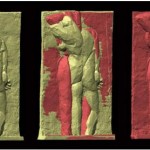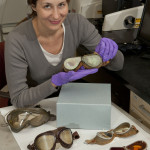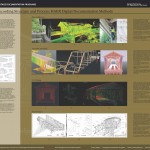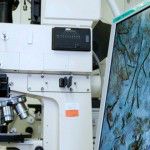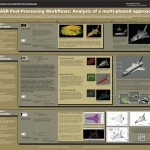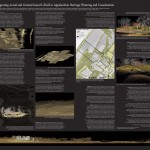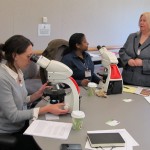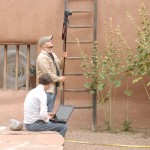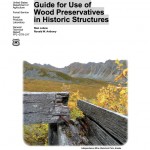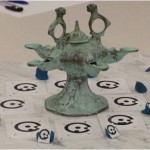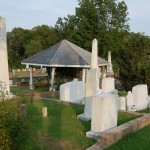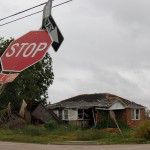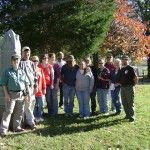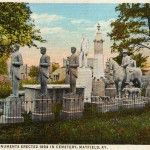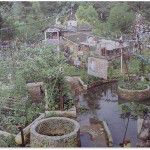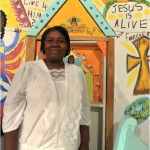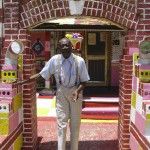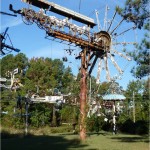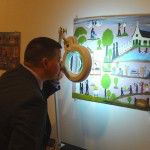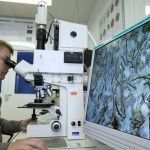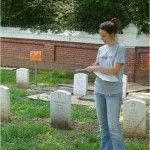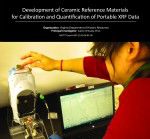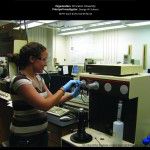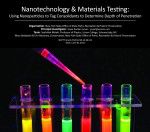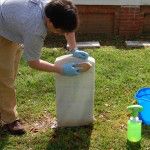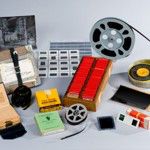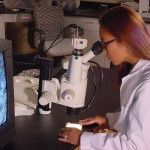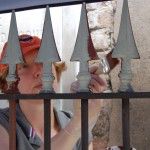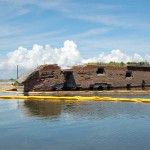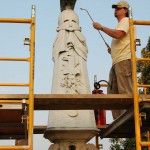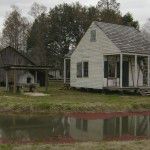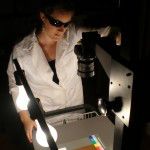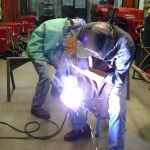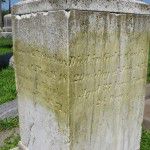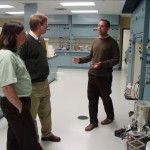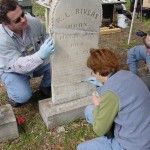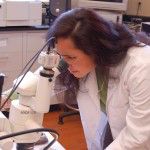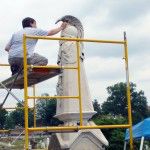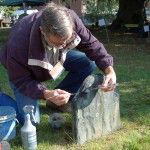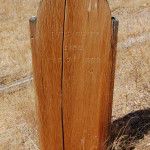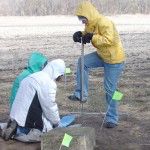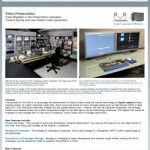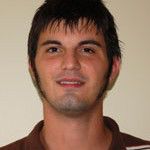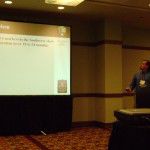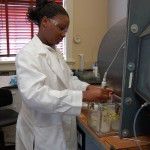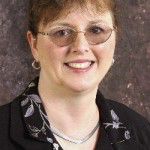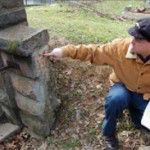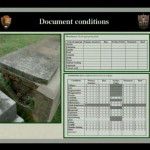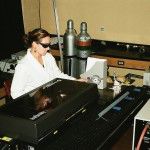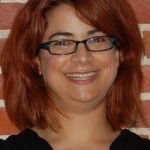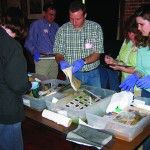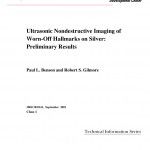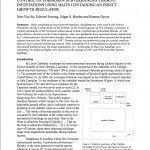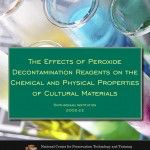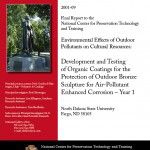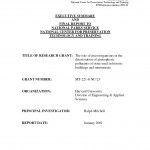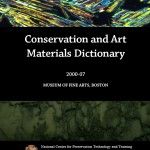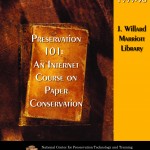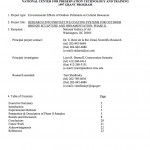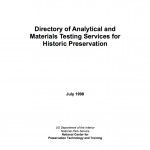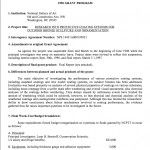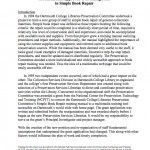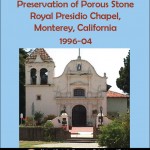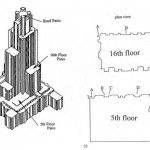NCPTT’s Materials Conservation Program works in partnership with parks, laboratories, government agencies, universities and others to understand how cultural objects deteriorate with time.
The program’s goals are
- to understand cultural resources decay,
- to develop and evaluate new treatments to protect cultural resources and
- to disseminate scientific results and preservation technologies through presentations, publications, and training for preservation professionals nationwide.
A special interest within the program is the study of outdoor air pollution effects on cultural materials. Research projects are developed internally at the NCPTT Environmental Exposure Facility located on the campus of Northwestern State University, Natchitoches, Louisiana, and externally through cooperative and interagency agreements, contracts and grants.
Partnering to Protect
The Materials Conservation Program seeks partnerships within both the public and private sector to collaborate on projects of mutual interest that advance preservation technology. For example, The U.S. General Services Administration (GSA) is responsible for Federal Properties across the country including many historic buildings. Currently they are establishing policies for the maintenance and treatment of terrazzo flooring found in may of these buildings. They lack the expertise to scientifically evaluate treatments. Together, the Materials Conservation Program and the GSA have joined to study and evaluate treatments such as vitriciation of terrazzo floors.
In order to understand the complex interactions of air pollution with materials, the Materials Conservation Program helped to develop a unique recirculating exposure chamber that allows us to expose materials such as stone or metal samples to air pollution under controlled conditions. Using this chamber, the uptake of pollution on surfaces can be measured. Researchers can look at how different features of the material affect pollution deposition and develop new treatments to minimize damage to materials. Currently, the program has initiated partnerships with organizations like DuPont Corporation to test new treatments for limestone and marble. The treatments may include stone strengtheners, pollutant repellents, or surface protectants.
Meeting the Needs of Preservation
In addition to our laboratory research, we actively look at preservation issues in the field. For example, the program is examining technical issues associated with the preservation of historic cemetery monuments. New technical approaches in cemetery preservation range from advances in databases and geographical information systems to new treatments to deter biological growth on stone. As we evaluate new treatments and methodologies, we seek field test sites for further trials. Based on our research, we offer cemetery monument conservation workshops advancing the latest knowledge in cemetery preservation.
Related Articles
| Name | Date |
|---|---|
| Cemetery Conservation Workshop in Natchez, Mississippi NCPTT, in partnership with the Historic Natchez Foundation will offer a cemetery monument conservation basics workshop May 11, 2013, in Natchez, Mississippi. The training is targeted to the nonprofessional, such as church sextons, genealogists, cemetery grounds workers, and family members. The workshop registration is $25 per person, this price includes a box lunch. The lecture portion ... | 02/27/2013 |
| KeckCAVES, Immersive 3D Visualization System for Cultural Sites (Podcast 41) In this episode, we join NCPTT’s Jason Church as he speaks with Marshall Millet, owner of MMars 4-D. Today they are talking about Millet’s work with U.C. Davis and the KeckCAVES visualization facility. | 02/15/2013 |
| Call for presentations, International Cemetery Preservation Summit Call for presentations and posters, International Cemetery Preservation Summit NCPTT is soliciting oral and poster presentations that focus on research and innovation in cemetery conservation and preservation for the NCPTT’s International Cemetery Preservation Summit to be held in Niagara Falls, NY, October 8-10, 2013. Topics for presentation may include recent developments in technologies, unique treatments, and creative ... | 02/13/2013 |
| 3D Scanning of Matisse, the Back I-IV: One Thing After Another This lecture was presented at the 3D Digital Documentation Summit held July 10-12, 2012 at the Presidio, San Francisco, CA 3D Scanning of Matisse, the Back I-IV: One Thing After Another Matisse created Back, his largest sculpture in 1908/1909. Matisse resculpted Back three times over the next twenty-one years (1913, 1917, 1930/31), each time beginning with a ... | 01/30/2013 |
| Looking through aviation “glass” to see the evolution of our plastic world If you have sat in the window seat, chances are you noticed that the airplane window was made of plastic. In fact, most aircraft include plastics in their design and have done so from the early years of human flight, yet the technological history of synthetic polymers in aviation is largely unexplored. This may be ... | 01/28/2013 |
| Comparing Digital Photogrammetric Methods for Preservation Documentation With a 2011 Grant from NCPTT, conservators at Georgia O’Keeffe’s Residences in Abiquiu and Ghost Ranch, New Mexico undertook research comaparing digital photogrammetric methods for preservation documentation of historic homes. They documented their project as they went along at http://okeeffeimagingproject.wordpress.com/. This project studied whether existing, three-dimensional (3D) digital photo imaging technologies could be easily adopted by ... | 01/28/2013 |
| Cooperation Creates A Custom Crate: Conservation, Laser Scanning, 3D Milling and Crate Building Work Together This poster was presented at the 3D Digital Documentation Summit held July 10-12, 2012 at the Presidio, San Francisco, CA. See Poster full detail and size COOPERATION CREATES A CUSTOM CRATE: Conservation, Laser Scanning, 3D Milling and Crate Building Work Together Claes Oldenburg’s Red Tights with Fragment 9 (1961) is created from single piece of contoured chicken wire, ... | 01/28/2013 |
| Recording Structure and Process: HAER 3D Digital Documentation Methods This poster was presented at the 3D Digital Documentation Summit held July 10-12, 2012 at the Presidio, San Fransisco, CA. See Poster full detail and size Recording Structure and Process: HAER 3D Digital Documentation Methods For many historic engineering works the structure’s historical significance is based on its structural design. This is especially true for bridges. By understanding ... | 01/28/2013 |
| Advances in Computational Photograph Techniques for Cultural, Historic, and Natural History Materials This lecture was presented at the 3D Digital Documentation Summit held July 10-12, 2012 at the Presidio, San Francisco, CA Advances in Computational Photograph Techniques for Cultural, Historic, and Natural History Materials This talk presents advances in robust new imaging tools from the emerging science known as Computational Photography. The common feature of the computational photography imaging ... | 01/25/2013 |
| Laser Scanning America’s Cultural Landscapes This poster was presented at the 3D Digital Documentation Summit held July 10-12, 2012 at the Presidio, San Francisco, CA. Poster full size and detail Laser Scanning America’s Cultural Landscapes The Historic American Landscapes Survey (HALS) Documentation to the Secretary of the Interior Standards, Assessing the Value of Laser Scan Data The Historic American Landscapes Survey (HALS) mission is ... | 01/23/2013 |
| Post-Processing Workflows: Identifying Hidden Costs in Converting Scan Data to Useable Information This poster was presented at the 3D Digital Documentation Summit held July 10-12, 2012 at the Presidio, San Fransisco, CA. See Full Detailed Poster Post-Processing Workflows: Identifying Hidden Costs in Converting Scan Data to Useable Information This poster aims to demonstrate the unique challenges associated with scanning and documenting OV-103 (Space Shuttle Discovery). In demonstrating the workflow ... | 01/23/2013 |
| 3D Data Recordation and Immersive Visualization: Considerations for Creative Mitigation Practices This poster was presented at the 3D Digital Documentation Summit held July 10-12, 2012 at the Presidio, San Fransisco, CA. See Poster full detail and size 3D Data Recordation and Immersive Visualization: Considerations for Creative Mitigation Practices The proposed presentation approaches the potential of 3d data collection and analysis in an immersive 3d visualization system, emphasizing digital format ... | 01/23/2013 |
| Integrating Aerial and Ground-based LiDAR in Appalachian Heritage Planning and Visualization This poster was presented at the 3D Digital Documentation Summit held July 10-12, 2012 at the Presidio, San Fransisco, CA. See Poster full detail and size Integrating Aerial and Ground-based LiDAR in Appalachian Heritage Planning and Visualization The Natural Resource Analysis Center (NRAC) at West Virginia University is building a portfolio of integrated LiDAR (Light Detection And Ranging) ... | 01/22/2013 |
| Mind the Gap: the Need to Supplement Laser Scan Data in HABS Documentation Projects This poster was presented at the 3D Digital Documentation Summit held July 10-12, 2012 at the Presidio, San Fransisco, CA. See Poster full detail and size Mind the Gap: the Need to Supplement Laser Scan Data in HABS Documentation Projects The HABS poster will discuss the use of laser scanning in relation to the documentation of historic buildings. ... | 01/20/2013 |
| Thin Section Petrography for Conservation (Podcast 40) Today we join NCPTT’s Mary Striegel as she speaks with Chandra Reedy. Reedy serves as Director of the Laboratory for Analysis of Cultural Materials in the Center for Historic Architecture and Design at the University of Delaware. Today we are talking to Chandra about the importance of thin section petrography for conservation. | 01/15/2013 |
| FAIC Cultural Recovery Center On October 29, 2012 Hurricane Sandy made landfall in the New York and New Jersey coastal area. The news covered the destruction, devastation and loss to homes, business, and families. In the weeks after the storm surge had receded we first started hearing about the loss and damage to cultural materials. The first time I ... | 01/14/2013 |
| Applications of Digital Photogrammetric Methods for Preservation Documentation of Historic Homes. (2012-11) Traditionally, conservators have relied on 2-dimensional (2D) photography to document and monitor conditions in heritage sites and objects. When a shocking, visual indicator appeared (e.g., a sudden crack in a surface), conservators took notice of what were actually thousands of slow, incremental changes (e.g., tiny fissures and failures in slowly aging materials). Conservators then photographed ... | 01/09/2013 |
| 2013 Summer Internships It’s more than just a job… it’s your future. Get hands-on experience and build your resume while preserving the history of our country. Summer internships at NCPTT provide students and recent graduates an opportunity to undertake laboratory or field research in archeology, architecture, engineering, collections management, historic landscapes, and materials science. What do interns do? Interns work in ... | 12/20/2012 |
| Cemetery Conservation Workshop in Natchez, Mississippi On December 1, 2012 NCPTT’s materials conservator Jason Church taught a one day cemetery conservation workshop in Natchez, Mississippi. This workshop was the first of a series being developed by the Historic Natchez Foundation with the Copiah-Lincoln Community College. Copiah-Lincoln Community College hopes this series of preservation related workshops will build interest in a developing ... | 12/20/2012 |
| Safe Hoist Operation for Lifting Stone Safe Hoist Operation for Lifting Stone When a stone needs to be removed or set back in place, lifting is required. A hoist or crane can be used whenever the stone cannot be moved manually. So, it is important to keep safety in mind when operating a crane or hoist. You should be familiar with the ... | 12/18/2012 |
| Calculating the Weight of Stone Calculating the Weight of Stone This is a guide intended to help anyone get the approximate weight of a stone without having to use a scale. The only required tools are a calculator, tape measure, pencil, and paper. Using the above tools allows the user to safely calculate weight prior to lifting stone with a hoist ... | 12/18/2012 |
| Designing the Lidar Mission for Industrial Heritage: Cooperation Across the Fields This lecture was presented at the 3D Digital Documentation Summit held July 10-12, 2012 at the Presidio, San Francisco, CA Designing the LiDAR Mission for Industrial Heritage: Cooperation Across the Fields Heritage managers and digital documentarians may observe the same subject, but observe it through a contrasting set of filters. The focus of this paper is to ... | 12/11/2012 |
| Fountain Fundamentals, an Ever Evolving Conservation Collaboration The National Center for Preservation Technology and Training in partnership with The Nelson-Atkins Museum of Art and conservator Martin Burke announces a two day conference on the conservation of fountains. The Nelson-Atkins Museum of Art in Kansas City, Missouri will host the conference which includes presented papers, poster presentations, and discussion sessions on July 10-11, ... | 11/27/2012 |
| Guide for Use of Wood Preservatives in Historic Structures (2012-10) This document provides guidance on wood preservation options in the context of historic preservation. Preserving wooden building materials is critical to historic preservation practitioners. Biodeterioration can be minimized through design, construction practices, maintenance, and, if neces¬sary, by use of wood preservatives. Moisture is the primary cause of biodeterioration, and if exposure to moisture cannot be ... | 11/16/2012 |
| Geophysical and Laser Scan Surveys at the Longfellow House – Washington’s Headquarters National Historic Site (2012-06) Geophysical and laser scan surveys were conducted at the Longfellow House – Washington’s Headquarters National Historic Site (NHS), Cambridge, Massachusetts in August, 2011. This work was undertaken as part of the Archaeological Survey Technology, Data Integration, and Applications (ASTDA) Workshop. This workshop was funded by the National Center for Preservation Technology Training and supported by the Joukowsky ... | 11/16/2012 |
| Petrographic Analysis for Conservation The National Center for Preservation Technology and Training (NCPTT) and The Center for Historic Architecture and Design (CHAD) in the University of Delaware’s School of Public Policy and Administration are partnering to host a two-day hands-on workshop on the uses of polarized light microscopy for the study of stone and ceramic cultural materials. The workshop ... | 11/15/2012 |
| Why DIGITAL? Its only 1′s and 0′s This lecture was presented at the 3D Digital Documentation Summit held July 10-12, 2012 at the Presidio, San Francisco, CA Why DIGITAL? Its only 1′s and 0′s We still seem to be fighting the war over the value of digital information some 30 years after its introduction to the public. Developments in technology have occurred so rapidly that skepticism ... | 11/09/2012 |
| Archive of Digital Data for HABS, HAER, and HALS Video in Production This lecture was presented at the 3D Digital Documentation Summit held July 10-12, 2012 at the Presidio, San Francisco, CA Archive of Digital Data for HABS, HAER, and HALS The NPS creates a variety of documents and records, such as inventory and monitoring plans, drawings, photographs, and conservation treatment records, to assist in the planning, ... | 11/06/2012 |
| Close Range Photogrammetry vs. 3D Scanning for Archaeological Documentation This lecture was presented at the 3D Digital Documentation Summit held July 10-12, 2012 at the Presidio, San Francisco, CA Close Range Photogrammetry vs. 3D Scanning for Archaeological Documentation The proliferation of terrestrial laser scanners on the market over the past few years has been accompanied by a rapid adoption of the technology by archaeologists. This increased archaeological use ... | 11/06/2012 |
| Our History Rests Here: Preservation and Restoration of Historic Cemeteries On September 20-21, 2012 NCPTT’s materials conservator Jason Church taught two cemetery monument conservation workshops as part of the Kentucky Heritage Council annual Historic Preservation Conference. Church’s contribution to the well attended and diverse annual conference was entitled “Our History Rests Here: Preservation and Restoration of Historic Cemeteries, Part 1 and Part 2″. The first day ... | 10/31/2012 |
| Cemetery Conservation Workshop in Natchez, Mississippi NCPTT, in partnership with the Historic Natchez Foundation and Copiah-Lincoln Community College, will offer a cemetery monument conservation basics workshop December 1, 2012, in Natchez, Mississippi. The training is targeted to the nonprofessional, such as church sextons, genealogists, cemetery grounds workers, and family members. The workshop registration is $25 per person, this price includes a ... | 10/30/2012 |
| Rocket Science and 3D Analyses in the Preservation of Artistic and Historic Works This presentation was presented as the keynote address for the 3D Digital Documentation Summit held July 10-12, 2012, Presidio, San Francisco, CA. Rocket Science and 3D Analyses in the Preservation of Artistic and Historic Works More than sixty years ago development began on the nuclear-propelled ORION Spaceship destined for a manned mission to the planet Saturn. This ... | 10/29/2012 |
| Highlights from the 12th Stone Congress — Part II Here are notes from three presentations I found interesting. I hope you’ll find them interesting, too. Interior Stone Cleaning at Saint John the Devine: practical and logistical considerations — Claudia Kavenagh While construction on the church was started in the 19th century, it is still not completed. During construction in 2001, a fire broke out that damaged ... | 10/29/2012 |
| Preparing for the Next Disaster Disasters can strike at anytime, sometimes with little or no warning. Experience has shown us that while natural disasters can leave a path of destruction there are also man-made disasters that can bring an area to its knees. Being informed and preparing for those that could affect you are key to saving your site, building ... | 10/29/2012 |
| NCPTT Research at International Stone Congress NCPTT’s Jason Church and Carol Chin presented research at the International Stone Congress on Wednesday, October 24. Church presented a comparative cleaning study for fragile marble monuments after pretreatment with hydroxyl conversion treatment. The purpose of this work was to develop a treatment methodology for the Arsenal and MaComb Monuments found in Congressional Cemetery, Washington, ... | 10/24/2012 |
| Monitoring Using Laser Scanning – Case Study of Watts Towers This lecture was presented at the 3D Digital Documentation Summit held July 10-12, 2012 at the Presidio, San Francisco, CA Monitoring Using Laser Scanning – Case Study of Watts Towers This paper will explore the use of laser scanning as a part of a controlled survey to measure movement of buildings and structures over time. In 2011 a ... | 10/22/2012 |
| Conservation Scientist for a Day 2013 Conservation Scientist for a Day One day event offered July 30, 2013 to students who have finished the 8th grade or those who participated in the 2013 NCPTT Robot Camp. $10 per person limited to 25 students STUDENTS WILL INVESTIGATE AUTHENIC POTTERY SHARDS AND PARTICIPATE IN HANDS-ON EXPERIMENTS! Instructors: Curtis Desselles, Carol Chin, Jason, Church, Mary Striegel | 10/18/2012 |
| Robotics Camp 2013 Learn: Soldering, Programming, Electronics, Robot Assembly, Navigation Using Sensors and More! Robotics Camp July 22-26, 2013 Who: Middle and High School Students(finished 6th grade to 12th grade) Location: National Center for PreservationTechnology and Training645 University ParkwayNatchitoches, LA 71457318-356-7444 Time: 9:00 AM to 12:00 Noon each day Attire: Casual Attire: Jeans and T-Shirts. Cost: • $50.00 Per Person •Limited to 15 students, payment in full is required at ... | 10/18/2012 |
| Evolution in Project Workflow – Is High Definition Survey the Missing Link? – Brandon C. Friske This lecture was presented at the 3D Digital Documentation Summit held July 10-12, 2012 at the Presidio, San Francisco, CA Evolution in Project Workflow – Is High Definition Survey the Missing Link? There is a major shift occurring in the preservation and building industry today. It was only 30 years ago that architects and engineers where designing ... | 10/18/2012 |
| 3D Technology and the H.I. Hunley: Beyond Documentation – Christopher Watters Since raising the H.L. Hunley submarine (1863) from the seabed in 2000, the project has incorporated 3D technologies including laser scanning, patterned light scanning, Vulcan point system, and computer modeling. Archaeologists developed the use of 3D technologies primarily for site plan development and artifact documentation. As the project progressed, conservators found other applications for the ... | 10/18/2012 |
| Two Additional 2012 PTT Grants Awarded Two additional grants totaling $50,000 were made to the following recipients. The Tulalip Tribes Hibulb Cultural Center is receiving $25,000 to develop a symposium on the Conservation and Continuation of Native American Monumental Wood Carving. The California Preservation Foundation is receiving $25,000 to advance distance learning through the Preservation Virtual Classroom. | 09/19/2012 |
| Summer Conservation Scientist for a Day Program Have you ever wondered what an art conservation scientist does? Have you thought about how science can teach us about an historic object? Come join us this summer and be your own scientific sleuth to learn about the culture of early inhabitants of Natchitoches through the pottery shards they left behind. NCPTT is offering a ... | 05/21/2012 |
| 2012 Robotics Camp NCPTT wants to introduce you to the excitement of science and technology through NCPTT’s 2012 Robotics Camp! Get hands-on experience building and programming your own robot. Then have a chance to test your navigational skills against others in the camp. You’ll learn about soldering, programming, electronics, robot assembly, navigation using sensors, and more! NCPTT’s 2012 Robotics ... | 05/21/2012 |
| Paradise Gardens; its Past and its Future This lecture was part of the Divine Disorder Conference on the Conservation of Outsider Folk art that was organized and hosted by NCPTT. The conference was held February 15-16, 2012 on the campus of Northwestern University in Natchitoches, Louisiana. Paradise Gardens; its Past and its Future Abstract Speakers Biography Jordan Poole,Executive Director Paradise Garden Foundation A Chattanooga County native Jordan ... | 04/20/2012 |
| Iron Fencing Care Workshop in Bloomington, Indiana NCPTT, in partnership with Monroe County History Center at Indiana University, conducted a workshop focused on the techniques and knowledge needed to preserve ornamental ironwork in an architectural setting. This workshop begin with an opening lecture session at 6:30 p.m. by NCPTT’s Materials Conservator Jason Church on Friday, October 14th at the History Center in Bloomington, Indiana. ... | 04/18/2012 |
| The Strange Procession That Never Moves The Wooldridge Monuments are a group of eighteen life-sized sculptures located in Maplewood Cemetery, Mayfield, Kentucky. Listed on the National Register of Historic Places, they commemorate the life and relatives of Henry G. Wooldridge. | 04/05/2012 |
| Planning to Stabilize, Document, Conserve and Interpret Howard Finster’s Paradise Garden in Summerville, Georgia This lecture was part of the Divine Disorder Conference on the Conservation of Outsider Folk art that was organized and hosted by NCPTT. The conference was held February 15-16, 2012 on the campus of Northwestern University in Natchitoches, Louisiana. Planning to Stabilize, Document, Conserve and Interpret Howard Finster’s Paradise Garden in Summerville, Georgia Abstract This presentation will illustrate ... | 04/04/2012 |
| The Orange Show Center for Visionary Art This lecture was part of the Divine Disorder Conference on the Conservation of Outsider Folk art that was organized and hosted by NCPTT. The conference was held February 15-16, 2012 on the campus of Northwestern University in Natchitoches, Louisiana. The Orange Show Center for Visionary Art Abstract The Orange Show Foundation Inc. recently received a grant from the ... | 04/04/2012 |
| Unicultural Ethnography: Preserving Outsider Art Through the Ethnography of Individual Outsider Artists This lecture was part of the Divine Disorder Conference on the Conservation of Outsider Folk art that was organized and hosted by NCPTT. The conference was held February 15-16, 2012 on the campus of Northwestern University in Natchitoches, Louisiana. Unicultural Ethnography: Preserving Outsider Art Through the Ethnography of Individual Outsider Artists Abstract Certain aspects of the artistic experience ... | 04/04/2012 |
| God’s Architects; Documenting the Materials, Methods, and Self-Taught Builders of the South This lecture was part of the Divine Disorder Conference on the Conservation of Outsider Folk art that was organized and hosted by NCPTT. The conference was held February 15-16, 2012 on the campus of Northwestern University in Natchitoches, Louisiana. God’s Architects; Documenting the Materials, Methods, and Self-Taught Builders of the South Abstract Scattered about remote back roads and ... | 04/04/2012 |
| Taking the Art to the Streets: How the Citizens of Los Angeles Saved Watts Towers This lecture was part of the Divine Disorder Conference on the Conservation of Outsider Folk art that was organized and hosted by NCPTT. The conference was held February 15-16, 2012 on the campus of Northwestern University in Natchitoches, Louisiana. Taking the Art to the Streets: How the Citizens of Los Angeles Saved Watts Towers Abstract When the assorted ... | 04/03/2012 |
| Thin-Section Petrography Workshop a Success Under the microscope sat a thin section of the smaller Bamiyan Buddha from Afghanistan which was destroyed in 2001. As polarizing filters were placed in front of and behind the sample creating cross polarization, grains of large quartz, feldspars, chert, and other components sparkled in vivid color on a dark background. This technique is called ... | 04/03/2012 |
| Creating a Conservation Plan for Vollis Simpson’s Whirligigs These lectures were part of the Divine Disorder Conference on the Conservation of Outsider Folk art that was organized and hosted by NCPTT. The conference was held February 15-16, 2012 on the campus of Northwestern University in Natchitoches, Louisiana. Dennis Montagna Creating a Conservation Plan for Vollis Simpson’s Whirligigs Abstract For the past thirty years, 92-year-old Vollis Simpson has ... | 04/03/2012 |
| Re-evaluation of 1984 Preservation Decisions for the African House Murals by Clementine Hunter This lecture was part of the Divine Disorder Conference on the Conservation of Outsider Folk art that was organized and hosted by NCPTT. The conference was held February 15-16, 2012 on the campus of Northwestern University in Natchitoches, Louisiana. Abstract Re-evaluation of 1984 Preservation Decisions for the African House Murals by Clementine Hunter In 1984 as an Associate ... | 04/03/2012 |
| The Greatest Show on Earth: the history and conservation of Jefferson Davis McKissack’s Orange Show This lecture was part of the Divine Disorder Conference on the Conservation of Outsider Folk art that was organized and hosted by NCPTT. The conference was held February 15-16, 2012 on the campus of Northwestern University in Natchitoches, Louisiana. The Greatest Show on Earth: the history and conservation of Jefferson Davis McKissack’s Orange Show Abstract The Orange Show ... | 04/03/2012 |
| Simon Rodia’s Towers in Watts (The Watts Towers) Four Decades of Interventions and Still Searching for a Solution This lecture was part of the Divine Disorder Conference on the Conservation of Outsider Folk art that was organized and hosted by NCPTT. The conference was held February 15-16, 2012 on the campus of Northwestern University in Natchitoches, Louisiana. Simon Rodia’s Towers in Watts (The Watts Towers) Four Decades of Interventions and Still Searching for a ... | 04/03/2012 |
| What’s In and What’s Out This lecture was part of the Divine Disorder Conference on the Conservation of Outsider Folk art that was organized and hosted by NCPTT. The conference was held February 15-16, 2012 on the campus of Northwestern University in Natchitoches, Louisiana. What’s In and What’s Out Abstract James Dixon (1887- 1970) was a primitive landscape painter from Tory Island an ... | 04/03/2012 |
| Virtual Conservation of Folk and Outsider Art Environments This lecture was part of the Divine Disorder Conference on the Conservation of Outsider Folk art that was organized and hosted by NCPTT. The conference was held February 15-16, 2012 on the campus of Northwestern University in Natchitoches, Louisiana. Virtual Conservation of Folk and Outsider Art Environments Abstract The presentation will address the issue of conserving documents pertaining ... | 04/03/2012 |
| A Creative Obsession: Materials and Techniques of the Self-Taught Artist James Castle This lecture was part of the Divine Disorder Conference on the Conservation of Outsider Folk art that was organized and hosted by NCPTT. The conference was held February 15-16, 2012 on the campus of Northwestern University in Natchitoches, Louisiana. A Creative Obsession: Materials and Techniques of the Self-Taught Artist James Castle Abstract Identifying the materials of works of ... | 04/02/2012 |
| Realms of the Unreal and the Henry Darger Archives This lecture was part of the Divine Disorder Conference on the Conservation of Outsider Folk art that was organized and hosted by NCPTT. The conference was held February 15-16, 2012 on the campus of Northwestern University in Natchitoches, Louisiana. Realms of the Unreal and the Henry Darger Archives Abstract The American Folk Art Museum maintains the single largest ... | 03/30/2012 |
| Magical Mosaics: Preserving Isaiah Zagar’s Philadelphia Art Environment This lecture was part of the Divine Disorder Conference on the Conservation of Outsider Folk art that was organized and hosted by NCPTT. The conference was held February 15-16, 2012 on the campus of Northwestern University in Natchitoches, Louisiana. Magical Mosaics: Preserving Isaiah Zagar’s Philadelphia Art Environment Abstract One of the nation’s most amazing, yet least known, art ... | 03/29/2012 |
| Discriminating Palettes: The Painting Materials of Clementine Hunter and Her Imitator This lecture was part of the Divine Disorder Conference on the Conservation of Outsider Folk art that was organized and hosted by NCPTT. The conference was held February 15-16, 2012 on the campus of Northwestern University in Natchitoches, Louisiana. Discriminating Palettes: The Painting Materials of Clementine Hunter and Her Imitator Abstract The paintings of Clementine Hunter, an illiterate ... | 03/29/2012 |
| FBI Investigation of Clementine Hunter Forgeries by William Toye United States Attorney Stephanie A. Finley announced that Robert E. Lucky, Jr, 64, of New Orleans, was sentenced today to 25 months in federal prison and was ordered to pay $326,893 in restitution for mail fraud in connection with selling fake paintings attributed to Louisiana artist Clementine Hunter. Lucky was also sentenced to three years’ ... | 03/28/2012 |
| John Pojman, LSU Polymer Expert, Visits NCPTT Monday’s meeting with Dr. John Pojman, an LSU professor specializing in polymers, was a great exchange of ideas. Pojman is a prototypical eccentric professor, who defines himself as a chemist, amateur herpetologist, and self-proclaimed owner of the world’s largest pocket protector collection. His is a gregarious researcher who can quickly go from a light-hearted story ... | 03/21/2012 |
| Clementine Hunter; History of Forgery The talk presents a biographical sketch of the folk artist, Clementine Hunter, born in southern Natchitoches Parish in late 1887 and died January 1, 1988. Around 2000 a group of paintings appeared on the market supposedly by Hunter but later found to be painted by Beryl and William Toye. The lecture will include details of the ... | 03/20/2012 |
| Reflectance Transformation Imaging Workshop, July 16-19, 2012 Cultural Heritage Imaging (C-H-I) is offering a four-day workshop on the use of reflectance transformation imaging (RTI) to document cultural heritage. The workshop will be held July 16-19, 2012 at the C-H-I offices in San Francisco, California. The new technique helps create digital representations of artifacts and sites. The workshop is a combination of lectures, demonstrations ... | 03/08/2012 |
| Petrographic Analysis for Conservation NCPTT, in partnership with the University of Delaware, will conduct a two-day workshop focused on a highly successful PTT grant by Chandra Reedy on Thin-Section Petrography of Stone and Ceramic Cultural Materials. The April 2012 workshop is open to 20 conservation professionals and will be held at the research laboratories of the National Conservation Training ... | 03/01/2012 |
| 3D Digital Documentation Summit July 10-12, 2012 at the Presidio of San Francisco, California NCPTT in conjunction with the Presidio Trust and the Friends of NCPTT will host a three day summit on digital documentation for the preservation of cultural heritage. The program features two days of contributed papers and a poster session, followed by a third day of field ... | 03/01/2012 |
| Preservation of Human Dental Surface Micro-Topography with Three-Dimensional Non-Destructive Digital Imaging (2012-01) Human skeletal remains from archeological sites are often studied to determine historical information such as sex, age, and health, among other facts. The information from individuals can be used to better understand a population and the culture of a past people. With the aid of a Preservation Technology and Training Grant, Dr. Shannon Hodge at ... | 02/28/2012 |
| Cemetery Documentation This webinar will cover the basics needed for Cemetery Documentation. The talk will run one hour of lecture with a following half hour for questions and answers. Topics covered in this talk will include an introduction to documentation surveys and forms followed by an overview of definitions general needed in cemetery documentation. Definitions covered are ... | 02/28/2012 |
| Evaluation of Ca(OH)2 Nano-Particle Treatment of Cordage/Basketry (2011-01) The major goals of this project involved: laboratory set-up; synthesis of Ca(OH) 2 nano- particles; cordage sample acquisition; development of a research design; preliminary testing of solutions and solvents; mechanical and aging studies; analytical characterization; imaging and data collection; and report preparation. The project has demonstrated that aqueous dispersions of calcium hydroxide nano-particles are not ... | 12/31/2011 |
| Development of a Micro-fading Tester with Near-UV Capability (2011-09) Paul Whitmore, director of Carnegie Mellon University’s Art Conservation Research Center (ACRC), has developed a portable device that can be used to determine how exposure to visible light and ultraviolet (UV) rays affect the colors on a work of art, providing vital information that can be used to better preserve the artwork. | 12/31/2011 |
| Controlling Salt Damage (2011-02) Growth of salt crystals within the pores of stone can cause serious damage. Salt may enter with ground water or be created by reaction of the minerals in the stone with atmospheric pollutants. As water evaporates from the pores of the stone, the salt concentration rises and the crystals grow until they approach the pore ... | 12/31/2011 |
| Development of Ceramic Reference Materials for Calibration and Quantification of Portable XRF Data (2011-06) While archaeologists have had some success identifying who made ceramics and where they made them, these techniques relied on removing a sample and complex instrumentation. The Virginia Department of Historic Resources (VDHR) used portable x-ray fluorescence (XRF) instrumentation as a tool to determine the geographic origin of Native American ceramics. | 12/31/2011 |
| A Polymeric Treatment for Controlling Salt Damage to Stone and Brick (2011-07) A recent NCPTT grant assisted a team from Princeton University’s Civil and Environmental Engineering Department to propose an approach on controlling salt damage. The goal of the project was to create a method for protecting stone from crystallizing salts by modifying the surface chemistry of the stone. Although frost and acid rain are more familiar ... | 12/31/2011 |
| Nanotechnology and Materials Testing: Using Nanoparticles to Tag Consolidant to Determine Depth of Penetration (2011-05) With a PTT grant funded by NCPTT, a research team including conservators from the New York State Bureau of Historic Sites, scientists with the Physics Department of Union College, Schenectady, New York, and scientists from the nanotechnology industry began experimenting with nanoparticles to advance conservation treatments in the field of historic preservation. This collaboration ... | 09/19/2011 |
| Limpieza Básica para Monumentos (2007-01) Hola, en este video le estaremos enseñando los procedimientos básicos para limpiar lápidas de piedra. Hay dos cosas que se deben de recordar: lo primero es que siempre hay que asegurarse de la seguridad personal y lo segundo es no hacer daño a la lápida como tal. | 09/15/2011 |
| NCPTT Seeks Grant Proposals from Preservation Innovators We are looking for proposals which develop new technologies or adapt existing technologies to preserve cultural resources. Call for Proposals (Details of the grants program) Optional Pre-Proposal (Due October 1, 2011) Submit Grant Proposal (Due October 17, 2011) | 09/01/2011 |
| Preparing Your Collection for a Disaster Preparing your collection for a disaster could greatly increase what survives. Northeast Document Conservation Center recommends to first prepare an emergency preparedness plan. This will allow your staff to respond quickly before, during and after a disaster with explict instructions that will provide the best practices for preparing and salvaging your collections. ... | 08/26/2011 |
| Preservation of Ornamental Iron NCPTT, in partnership with Monroe County History Center at Indiana University, will conduct a workshop focused on the techniques and knowledge needed to preserve ornamental ironwork in an architectural setting, October 7-8, 2011 in Bloomington, Ind.. The class will be split between classroom lectures and in the field hands-on activities. For more information contact Jason ... | 08/11/2011 |
| New Study Expands Research for Removing Crude Oil from Historic Brick Since the summer of 2010, NCPTT has been actively researching the removal of crude oil from objects and sites of cultural significance, such as Fort Livingston. This 19th century coastal fort on Grand Terre Island, Louisiana, was badly contaminated by the 2010 Deepwater Horizon oil spill. Our scientists visited the site twice last year to ... | 08/08/2011 |
| Protecting Archeological Objects from Crude Oil In the wake of recent oil spills, many in the public sector recognized a need for concise, reliable information to protect cultural heritage from the long-term effects of crude oil. In particular, government officials, archeologists, and preservation professionals wanted to know the risks associated with crude oil contamination on buried and submerged archeological objects and ... | 07/21/2011 |
| Best Practice Recommendations for Cleaning Government-Issued Marble Headstones(2011-13) In 2004, the Department of Veteran Affairs National Cemetery Administration turned to NCPTT when it wanted advice on chemical cleaners for their marble headstones. This began and partnership and extensive research on the subject of commercially available cleaners for removing biological growth and general soiling from marble headstones. This week, NCPTT’s Mary Striegel reported the results ... | 07/21/2011 |
| Cold Storage for Photographic Materials Tuesday, August 2, 2011 at 2:00 pm EDT Theresa Anne Voellinger, Paper/Photograph Conservator, Harpers Ferry Center, National Park Service will join us to discuss the Connecting to Collections Online Community’s Featured Resource for August – the online video series Cold Storage: A Long-Term Preservation Strategy for Film-Based Photographic Materials. To join these events, go to http://www.connectingtocollections.org/ and visit the meeting ... | 07/20/2011 |
| Identifying Museum Insect Pest Damage Wednesday, July 20, 2011 at 3:00 pm EDT Led by Barbara Cumberland, Conservator, Museum Conservation Services at the Harpers Ferry Center, National Park Service, and Carol DiSalvo, Integrated Pest Management Coordinator at the National Park Service. The following resources are recommended for this webinar: Identifying Museum Insect Pest Damage (PDF) 11 Step Process for Implementing an Integrated Pest ... | 07/20/2011 |
| Our Rule of Three: Producing a Video on Statue Conservation Have you ever been to Gettysburg or other battlefield sites and noticed the condition of the outdoor sculptures? Or, closer to home, are there any commemorative markers or metal plaques on your way to work today that are in poor condition? Most National Parks and almost every town square have at least one outdoor ... | 07/05/2011 |
| Cultural Heritage Recovery in Haiti (Podcast 31) Welcome to the Preservation Technology podcast; the show that brings you the people and projects that are advancing the future of America’s heritage. I’m Kevin Ammons with the National Park Service’s National Center for Preservation Technology and Training. Today we join Jason Church as he speaks with Karen Pavelka, a lecturer in the School of ... | 05/03/2011 |
| Conservation Scientist for a Day What will students learn from the “Conservation Scientist for a Day” program? Students will learn about: The role of the conservation scientist, The Scientific Method, Conservation, Cultural heritage, X-ray fluorescence (XRF) theory, The Metric System, Chemical analysis testing, and Safety in the laboratory setting. | 03/25/2011 |
| Ornamental Iron Workshop 2011 May 18-19, 2011 Savannah, GA The purpose of this event is to educate people about the differences in cast and wrought iron and preservation/restoration methods for each type of material. This workshop will be useful to anyone who cares for historic buildings (that contain railings, balconies, or other decorative elements), parks, or cemeteries. $399 Registration $299 Student Registration – ... | 02/15/2011 |
| National Science Foundation Grant Enables Scientists to Advance Stone Treatments The National Science Foundation has awarded a $360,000 three-year grant for preservation research to the University of Southern Mississippi, Hybrid Plastics, and the National Center for Preservation Technology and Training (NCPTT). The research team is developing new stone strengtheners, also called consolidants, based on the latest advances in polymer science. “This National Science Foundation grant ... | 02/02/2011 |
| A Better Picture of the Past Using New Technologies Can chemistry lead to better understanding of archeological objects? Ask Dr. Evan Peacock from the Cobb Institute of Archaeology at Mississippi State University. With funding from NCPTT, Peacock is using an analytical technique called Laser Ablation-inductively Coupled Plasma-Mass Spectrometry (LA-ICP-MS) analyzing spoons made of freshwater mussel shell. Spoons like these were used to smooth pottery ... | 02/01/2011 |
| Field Report: Fort Livingston, Grand Terre Island NCPTT made a second visit to Fort Livingston, Grand Terre Island, in September, 2010. Eight surface washing agents were tested for their effectiveness in removing weathered crude oil from the brick masonry at the fort. A few of the products tested were somewhat effective, removing approximately 50% to 70% of the surface soiling from the ... | 01/14/2011 |
| Cemetery Monument Conservation Basics: Sand Hill, TX Location: Sand Hill, TX Date: April 2011 Partner: Stephen F. Austin State University Description: This cemetery basics workshop is targeted to the parks seasonal interpretation staff, regular yearly staff, and family members of the cemeteries located at the park. This one to two day workshop will focus on cemetery documentation, condition assessment, master plans, simple resetting techniques, and ... | 01/12/2011 |
| Cemetery Conservation Techniques: St. Augustine, FL Location: Saint Augustine, FL Date: April 1-2, 2011 Partner: University of Florida This multiday cemetery workshop will focus on a variety of cemetery materials and conservation treatments. This includes proper cleaning and consolidation techniques for stone grave markers, lime washing of build features, and simple repair techniques for stone. A small class of 15-20 will be comprised ... | 01/12/2011 |
| Cemetery Monument Conservation: Cherokee, NC This Cemetery Monument Conservation Basics workshop is a partnership between Great Smokey Mountains National Park and NCPTT. It is targeted to the parks seasonal interpretation staff, regular yearly staff, and family members of the cemeteries located at the park. This one to two day workshop will focus on cemetery documentation, condition assessment, master plans, simple ... | 01/12/2011 |
| Cemetery Monument Conservation Basics: Peoria, IL NCPTT has partnered with the Illinois Historic Preservation Agency and Springdale Cemetery Association to offer Cemetery Monument Conservation Basics in Peoria, IL. This cemetery basics workshop is targeted to the nonprofessional, such as church sextons, genealogists, cemetery grounds workers, and family members. This one day workshop will focus on cemetery documentation, condition assessment, master ... | 01/12/2011 |
| Ft. Livingston, Grand Terre Island Field Report (2010-03) NCPTT staff visited Fort Livingston, Grand Terre Island, on June 16, 2010 to evaluate the condition of the structure and the amount of oil contamination; to conduct field tests on cleaning methods; and to collect oil, water, and oil-contaminated sand samples for further testing in the laboratory. The amount of oil and area of contamination ... | 12/31/2010 |
| University Concludes 100-year Concrete Study The University of Wisconsin at Madison recently wrapped-up a research project begun in 1910 to examine the long-term performance of concrete samples stored under different conditions. When Owen Withey, a professor of mechanics at the university, began his study at the turn of the last century there had been little scientific research of concrete and ... | 12/20/2010 |
| NCPTT, Southern Miss and Hybrid Plastics Collaborate to Study Stone Strengtheners (Podcast 26) In this edition of the Preservation Technology Podcast, we join NCPTT’s Jason Church as he speaks with Derek Patton, Assistant Professor in the School of Polymers and High Performance Materials at The University of Southern Mississippi. NCPTT is partnering with USM and Hybrid Plastics on a National Science Foundation grant to advance the science of ... | 12/07/2010 |
| 2010 Annual Report The NCPTT 2010 Annual Report outlines research, training, and grant activities undertaken by the Center during FY2010. NCPTT advances the application of science and technology to historic preservation. Working in the fields of archeology, architecture, landscape architecture and materials conservation, the Center accomplishes its mission through training, education, research, technology transfer and partnerships. | 10/20/2010 |
| Creation of a Web-accessible Database of the Comparative Plant Fiber Collection (2010-02) This database of micrographs of textile fibers acquired through the use of multiple microscopic techniques contains 145 collections with 1404 individual files, and requires 23GB of storage space. Each file contains a high resolution image with text fields that delineate image location and size, image collection information, microscopy technique and details of the features presented ... | 10/06/2010 |
| New National Science Foundation Grant Enables NCPTT to Advance Stone Treatments Researchers at NCPTT are discovering new treatments for historic stone conservation with the help of Hybrid Plastics, the University of Southern Mississippi, and a grant from the National Science Foundation. The team is developing new stone strengtheners, also called consolidants, based on the latest advances in polymer science. The National Science Foundation is awarding the ... | 09/23/2010 |
| Video: The Historic Building Material Bousillage In this video we will discuss a traditional Louisiana construction method called Bousillage. Bousillage is a Louisiana French term for walls made of mud. The origins of the word comes from Bous which means mud. Louisiana’s bousillage techniques appear s to be a blending of French and Native American traditions. Both cultures employed similar mud walled ... | 09/02/2010 |
| NDSU studies protective coatings for outdoor bronze sculpture Some of the world’s most famous art will never appear in a gallery. Indeed, outdoor bronze sculpture may spend decades or centuries outdoors, exposed to pollution and extreme weather conditions. Researchers at North Dakota State University (NDSU) used a grant from NCPTT to study ways to test and develop a coating system to resist corrosion ... | 09/02/2010 |
| Protecting Historic Structures from Oil Contamination This document is written as general guidance for property owners, as well as state and federal officials, for the care of historic structures facing the impact of oil contamination from releases of crude oil in marine and terrestrial environments, whether from oil tankers, drilling rigs, wells, offshore platforms, or pipeline breaks and failures. | 07/30/2010 |
| NCPTT works for long-term protection of cultural resources in the Gulf The effects of oil contamination on cultural resources will continue to be a challenge to the Gulf Coast region for years to come. NCPTT is meeting this challenge with technical research support for state and federal land managers, and for the public. | 07/26/2010 |
| Folk Art Conservation and the Rock Garden in Chandigarh, India (Podcast 22) In this edition of the podcast, we join NCPTT’s Jason Church as he speaks with Tony Rajer. He is an Art Conservator with the Nek Chand Foundation and a conservation professor at the University of Wisconsin. Today they will discuss Rajer’s interest in folk art and his work with the Rock Garden in Chandigarh, India. | 07/21/2010 |
| Materials Research Program Begins Rust Converter Study For conservators working with iron, rust is always a consideration. In museum collections or in our homes, we easily encounter rusty fences, grates, car parts, artwork and collectibles. Iron oxide (commonly called rust) results from the natural oxidation of iron by oxygen. Some metals, like bronze, can form a protective layer of corrosion products called ... | 06/22/2010 |
| Preservation of Iron and Steel in Bridges and Metal Structures (Podcast 17) In this episode of the Preservation Technology Podcast, we join NCPTT’s Jason Church as he speaks with Vern Mesler, adjunct professor at Lansing Community College. They will discuss the “Preservation of Iron and Steel and Bridges and Other Metal Structures Workshop,” which was funded by a grant from the National Center. | 04/13/2010 |
| Researchers examine methods to control salt damage in cultural resources Salt damage is one of the leading causes of deterioration of monuments and historical buildings. While this problem is widespread, proper prevention methods are not understood, leading to remedies that sometimes cause additional harm. Princeton University is tackling the problem by using strategies to better understand the salt/water/pore interface. University researchers are using a PTT ... | 03/30/2010 |
| NCPTT Hosts School Groups for Heritage Education Lessons In an ongoing commitment to promote heritage education in historic preservation, the Materials Research Program at NCPTT recently hosted two school groups. On Friday, March 12, thirty-four Avoyelles Public Charter School high school juniors took part in the “Conservation Scientist for a Day” lesson. For this the students studied French colonial and Native American pottery using ... | 03/25/2010 |
| NCPTT Training Video: Lifting and Hoisting Stone Grave Markers Many fallen or sunken grave markers are too large or weigh too much to be reset by hand. For these markers a mechanical hoisting or lifting system must be used. There are many types of lifting systems in use from very complex cranes and truck mounted hydraulic booms to less complex gantries and tripod hoists. ... | 03/21/2010 |
| Looking through Corrosion: A Workshop On Eddy Current Analysis for Cultural Heritage Have you ever wondered what kind of metal that object was made of? Or perhaps you needed to read the inscription of a coin that was corroded. Maybe you have a laboratory with a limited research budget and need to study a collection of firearms. NCPTT is researching new applications for an old technology: Eddy ... | 02/09/2010 |
| NCPTT 2010 Call for Interns NCPTT has internships available in the fields of historic architecture, materials conservation, and historic landscapes. Positions include 10-week historic architecture and materials conservation summer internships and a 6-month historic landscapes internship. | 01/15/2010 |
| 3-D laser scanning opens new doors for preservation technology research The Konica Minolta Vivid 9i 3-D LASER scanner has been used to create better computer graphics in movies such as Bolt and The Golden Compass. It was also used to make online museums, such as the Virtual Hampson Museum, with 3-D images of every artifact. Now NCPTT will expand its use into the preservation field. | 01/07/2010 |
| Establishing an Elemental Baseline for Sourcing Shell and Shell-Tempered Artifacts in the Eastern Woodlands of North America using Laser Ablation-Inductively Coupled Plasma-Mass Spectrometry (LA-ICP-MS): Final Report (2009-02) This project involved developing a new method for using the chemical content of freshwater mussel shell as a means of sourcing prehistoric, shell-tempered pottery and shell artifacts to their places of origin. By extension, this means that prehistoric trade and exchange networks can be mapped out. Because each waterway is chemically different to some extent, ... | 12/31/2009 |
| Evaluation of Conservation and Preservation Practices in a Southwest Pottery Collection (2009-04) A variety of materials and methods have been used to preserve ceramic vessels. Many have proven successful, while others are damaging. Monitoring and evaluation of past treatments is a documented research priority in the conservation field. The Arizona State Museum (ASM) has examined, recorded and analyzed the performance of past treatments on ... | 12/31/2009 |
| Hands-on Preservation and Conservation: NCPTT Materials Research Program 2009 Annual Report The best preservation decisions are based on first-hand knowledge. NCPTT is creating new technology-based information for people active in hands-on preservation and conservation. NCPTT contributed its first-hand knowledge to the Department of Defense in 2009. Recently, the DOD wished to establish a series of standard rehabilitation treatments for better management of its built heritage. Initial drafts ... | 11/30/2009 |
| PTT Grant is funding database for research of fibers Ohio State University is looking to provide ethnobotanists, archeologists and analysts with a new way to identify fibers found in prehistoric artifacts. Through a grant from NCPTT, the university is creating an online database containing digital images, explanatory text and terminology that is designed to give researchers important information about artifacts. | 10/01/2009 |
| Live Webcast – Nationwide Cemetery Preservation Summit A live webcast of the Nationwide Cemetery Preservation Summit was streamed on October 19. 2009. View the webcast. | 10/01/2009 |
| Chemistry and Materials Research at the Interface between Science and Art: Thoughts from an NSF Workshop co-sponsored by the Andrew W. Mellon Foundation and Northwestern University Chemistry and Materials Research at the Interface between Science and Art: Thoughts from an NSF Workshop co-sponsored by the Andrew W. Mellon Foundation and Northwestern University In July, I was invited to participate in a National Science Foundation workshop entitled “Chemistry and Materials Research at the Interface between Science and Art.” I had the good fortune ... | 09/04/2009 |
| Using Eddy Current Technology in Conservation Science (Podcast 8) In this episode, Jason Church speaks with Curtis Deselles, an intern with the Materials Research program at NCPTT, discusses the use of eddy currents and eddy current technology in conservation science. Mr. Deselles has built several eddy current analyzers, custom software, and presented on this topic at a non-destructive conference in St. Louis. NCPTT has been ... | 08/12/2009 |
| PTTGrant project to create user-powered online database for historic landscapes The Cultural Landscape Foundation (TCLF) is creating a new, interactive way of preserving historic landscapes. Slated for launch in October, the PTTGrant-funded “What’s Out There” project will raise awareness about the wide range and diversity of historic landscape design through a collaborative Wikipedia-style website. The site will enable users to directly contribute information, resulting in ... | 08/03/2009 |
| DOD Standard Treatments NCPTT has completed the rewriting and editing of 12 Standard Treatments for the DOD. Sixteen additional treatments are under review, and DOD comments will be incorporated as they are received. This effort is directed at improving the technical content of the draft DOD treatment standards and the stewardship of DOD cultural resources. | 07/27/2009 |
| NSF Workshop NCPTT’s Mary Striegel participated in a National Science Foundation/Andrew Mellon Foundation workshop held to examine and improve the state of science used to study, preserve and protect cultural patrimony. Forty participants met to identify areas where new research in basic science can provide a foundation for significant improvements in understanding the way art and artifacts were ... | 07/21/2009 |
| Using Lasers to Remove Graffiti from Rock Art and Rock Imagery (Podcast 7) Today we are joining NCPTT’s Jason Church as he speaks with Claire Dean of Dean Associates of Conservation Services about using lasers to remove graffiti from rock art. Rock art or rock imagery is the common term for paintings and carvings on rock and in North America that is mostly associated with native communities. Download Episode ... | 07/16/2009 |
| The Aftershock of Economics Meets Conservation Online When the use of the internet for communication is exploding exponentially, the economics of California and Stanford University has brought an end to the Conservation Online DistList and Archives (CoOL). | 06/15/2009 |
| Nationwide Cemetery Preservation Summit Abstracts and Video Schedule and abstracts for the Nationwide Cemetery Preservation Summit from October 19-21, 2009 in Nashville, Tennessee. Register before September 11, 2009 for $299 ($399 thereafter). Key sessions are expected to include Archeology, Mapping and Documentation, Landscapes, Engineering Challenges, Issues in National Cemeteries, and Materials Conservation. | 04/20/2009 |
| Shaving Cream: Genealogist’s Friend or Cemetery Conservator’s Foe? We do not advocate the use of shaving cream for investigating inscriptions on stone. The shaving cream has natural emollients for softening the skin. These emollients have oils and moisture holding agents that can have detrimental effects on the stone. | 04/09/2009 |
| NCPTT visits Hybrid Plastics NCPTT and Hybrid Plastics are partnering to make and use POSS modified polymers in preservation applications. Researchers and preservationists discussed the potential of developing new nanotechnologies for application to preservation problems. | 04/07/2009 |
| Deadline: Call for Presentations for the Nationwide Cemetery Preservation Summit NCPTT is soliciting oral and poster presentations that focus on research and innovation in cemetery conservation and preservation for the NCPTT’s Nationwide Cemetery Preservation Summit to be held in Nashville, Tenn., October 19-21, 2009. | 03/31/2009 |
| Essentials for Cemetery Monument Care TelNPS This course emphasizes sound maintenance techniques for cemetery and commemorative monuments that are sustainable, cyclic, non-invasive, and do no harm. The course will address documentation, maintenance plans, stone deterioration, cleaning, and resetting headstones. | 03/09/2009 |
| Basics for Iron Fencing Care TelNPS This course emphasizes sound maintenance technqiues for historic iron fences. These resources could be located around cemetery markers, commemorative monuments, or architectural features. | 03/09/2009 |
| Mary Striegel to Keynote at American Society for Non-Destructive Testing Mary Striegel will be the keynote speaker at the annual meeting of the American Society for Non-destructive Testing, to be held March 17 in St. Louis, Mo. | 03/03/2009 |
| New Life for Native Artifacts Recent research reveals bacteria may be the biggest ally in the fight to preserve ancient artifacts from erosion and deterioration. | 03/01/2009 |
| Eddy Current Metal Testing in Conservation Workshop The topic is the use of eddy currents for identification of metals (ferrous and non-ferrous), measuring the thickness of corrosion, and the recovery of serial numbers and/or images beneath corrosion. | 02/13/2009 |
| Non-destructive testing to be the topic of session meeting, keynote address NCPTT is organizing a session on non-destructive testing in historic preservation as part of the American Society for Non-destructive Testing’s meeting on March 17, 2009 in St. Louis. | 02/10/2009 |
| Dynamics of Participatory Conservation: The Kamehameha I Sculpture Project The conservation of the King Kamehameha I sculpture in North Kohola, Hawai`I demonstrates a dynamic of public involvement in conservation. | 02/09/2009 |
| The Other White “Paint” Limewash is enjoying renewed interest as a protectant for historic structures, thanks in part to research undertaken by NCPTT and its partners. | 02/05/2009 |
| Carol Chin joins NCPTT research staff Carol Chin has joined NCPTT as a joint faculty researcher in the National Center’s Materials Research Program. The position is held in partnership with Northwestern State University of Louisiana | 01/28/2009 |
| NCPTT completes Historic Congressional Cemetery Monuments Study NCPTT researchers, in partnership with masonry experts from NPS Historic Preservation Training Center, recently completed a study to develop treatments for use on marble monuments in Historic Congressional Cemetery. | 01/20/2009 |
| Documentation of Timbisha Shoshone Traditional Cultural Sites Using Video and GIS Technology The grant allowed for documentation of traditional language, foods, music and the cultural landscapes associated with the Timbisha Shoshone people in their aboriginal territories. | 01/01/2009 |
| Development of a Rapid Indicator of Biodeterioration of Historic Stone (2008-09) 2006 NCPTT Grant to Harvard University, “Development of a Rapid Indicator of Biodeterioration of Historic Stone.” Biodeterioration plays an important role in the degradation of stone in historic buildings, monuments, and archeological sites. | 12/31/2008 |
| Limewash Video: Application and Preparation of Limewash (2008-07) This six minute video explains how to prepare and apply limewash. | 12/31/2008 |
| NCPTT Awarded Second Consecutive Fuller Award from APTI NCPTT was awarded the Oliver Torrey Fuller Award at the Association of Preservation Technology International (APTI) conference in October. | 11/13/2008 |
| NCPTT holds sixth Cemetery Monument Conservation Workshop NCPTT’s held its sixth annual Cemetery Monument Conservation workshop October 7-9, 2008, in New London, Connecticut. Twenty-six registrants participated in a variety of hands-on sessions. | 11/13/2008 |
| Wooden Artifacts in Cemeteries: A Reference Manual NCPTT has received the PTT grant product “Wooden Artifacts in Cemeteries: A Reference Manual,” submitted by the Historic Preservation Commission; the City of Aspen, Colorado, and Anthony & Associates. | 11/13/2008 |
| Partnership studies environmentally friendly cleaner on historic monument NCPTT and the NPS Historic Preservation Training Center (HPTC) are partnering with the Veterans Administration’s National Cemetery Administration to complete cleaning treatment studies on the U.S. Arsenal Monument in Historic Congressional Cemetery. Based on research and training by NCPTT’s Jason Church, HPTC staff will undertake intermittent misting cleaning of the Arsenal Monument during November. This ... | 11/13/2008 |
| Comparative Study of Commercially Available Cleaners for Use on Federally-Issued Headstones This report provides information and progress on the comparative study of commercially available cleaners for federally issued headstones. | 10/20/2008 |
| Digital Image Analysis of Petrographic Thin Sections in Conservation Research (2004-01) Traditional thin-section analysis techniques such as tedious manual point counting are time consuming and require numerous measures. The use of visual estimation charts produce results of questionable accuracy. | 09/22/2008 |
| Protective Glazing Study (1996-06) In this study, Inspired Partnerships, a non-profit organization in Chicago, investigated the virtues and liabilities of various protective glazing installations over stained glass. | 09/22/2008 |
| Historic Resource Surveys and the Internet (1999-10) This manual teaches communities and neighborhoods how to complete their own historic resource surveys and share that information quickly. | 09/22/2008 |
| Glass and Stained Glass Conservation (1998-28) This video covers a workshop on the conservation and restoration of stained glass. | 09/22/2008 |
| Identification of Unmarked Graves A critical and long-standing challenge in the preservation field has been finding unmarked graves. | 09/16/2008 |
| New Custom Polymers Technology NCPTT’s materials research program hosted representatives from Hybrid Plastics. The company specializes in new resin and plastics based on a new chemical technology called POSS. | 09/10/2008 |
| Development of a Handheld Metal Tester Using Eddy Current Technology NCPTT’s Curtis Deselles, a graduate student in the Masters of Heritage Resources program at Northwestern State University of Louisiana, is developing a handheld metal tester using eddy current technology. | 08/01/2008 |
| New England Cemetery Monument Conservation Workshop NCPTT and the City of New London will deliver the sixth annual New England Cemetery Monument Conservation workshop on October 7-9, 2008, in New London, Conn. | 08/01/2008 |
| Removal of Graffiti from Brick Masonry Buildings NCPTT is developing better strategies for the removal of graffiti from brick masonry buildings. | 08/01/2008 |
| Interactions Between Air Pollution and Limestone Molly McGath, NCPTT summer intern, is studying interactions between air pollution and limestone treated with commonly used chemical stone strengtheners. | 08/01/2008 |
| $165,415 Released for the National Center for Preservation Technology and Training Grants Program More than $165,000 will fund research to protect America’s historic legacy as part of the National Center for Preservation Technology & Training’s PTT Grants program. | 07/09/2008 |
| Vacancy Announcement: Preservation Scientist The National Center for Preservation Technology and Training (NCPTT) and Northwestern State University seek a Ph.D. analytical, organic, or physical chemist to fill a joint-faculty position for two years, with an option for annual renewal pending availability of funds. | 07/01/2008 |
| Anna Johnson Presents NCPTT Research at Intel International Science and Engineering Fair Anna Johnson, a high-school junior at the Louisiana School for Math, Science and the Arts, took NCPTT research to the Intel International Science and Engineering Fair, Atlanta, Ga. on May 11-16. | 06/17/2008 |
| Stace Miller Awarded B.S. in Chemistry and Math Stace Miller, a longtime undergraduate intern at NCPTT, received a B.S. in chemistry and an B.S. in Math from Northwestern State University of Louisiana on May 9. | 06/10/2008 |
| Interim Report on Commercially Available Cleaners for use on Federally issued Headstones NCPTT and the Department of Veteran Affairs, National Cemetery Administration has released the interim report entitled, Comparative Study of Commercially Available Cleaners for use on Federally-issued Headstones. | 06/09/2008 |
| Portable Laser for Graffiti Removal The Los Angeles County Museum of Art recently provided a portable laser system to NCPTT as part of the National Center’s laser research facility. | 06/03/2008 |
| Limewash: Handmade and Modern Brick This report is an executive summary of testing undertaken by NCPTT in partnership with the Cane River Creole National Historical Park (CARI) and Quality Finish. | 05/24/2008 |
| Materials Research Hosts Four Summer Interns NCPTT will host four interns in its materials research program this summer: Molly McGath, Catherine Arseneaux, Candida D’Avanzo, and Paige Isaacs. | 05/23/2008 |
| Durability of Traditional and Modified Limewashes The study tested a variety of limewash recipes for possible use on historic structures located in the Cane River Creole National Historical Park, located in central Louisiana. | 05/20/2008 |
| NCPTT Research Presented at AIC Jason Church and Stace Miller presented results of NCPTT research at the annual meeting of the American Institute for Conservation in Denver Colorado, April 21-24. | 05/09/2008 |
| New England Cemetery Monument Conservation Workshop: October 7-9, 2008 $695 per participant. Topics Will Include: Condition Assessments, Conservation Ethics, Protection, Cleaning, Stone Loss Repairs, Bases and Resetting, Adhesion & Reinforced Repair, Consolidation. | 04/23/2008 |
| Striegel Presents ‘Protecting and Preserving Louisiana’s Historic Legacy’ Mary Striegel of NCPTT presented at the 2008 Louisiana Library Association Annual Meeting, held March 4-6 in Shreveport. | 04/22/2008 |
| Miller and Kurshid Receive Awards from ACS NCPTT interns Stace Miller and Bilal Khurshid were acknowledged for their research and professional presentations at NSU’s Annual College of Science and Technology banquet. | 04/10/2008 |
| NCPTT Staff Presents Research at NSU Six NCPTT staff members presented at Northwestern State University of Louisiana’s (NSU) annual research day on March 20. | 04/09/2008 |
| Cultural Resources Diversity Intern to Develop Oral Traditions Project NCPTT has been granted a cultural diversity intern for summer 2008 through the NPS Cultural Resources Diversity Internship Program. | 03/28/2008 |
| NCPTT Installs FTIR Spectrometric Microscope to Analyze Cultural Materials A new Perkin Elmer Fourier Transform Infra-Red (FTIR) spectrometric microscope was recently installed in the NCPTT research labs. | 02/18/2008 |
| Basics in Iron Fence Care Materials Research Chief Mary Striegel and Materials Conservator Jason Church conduct a TEL NPS course “Essentials in Cemetery Monument Care.” | 02/07/2008 |
| NCPTT Provides Archeology Technical Assistance to Louisiana State Exhibit Museum NCPTT recently provided technical assistance to the Louisiana State Exhibit Museum in Shreveport regarding concerns about the condition of several archeological copper objects associated with the Gahagan burials that were excavated in the 1930s. | 02/04/2008 |
| Essentials in Cemetery Monument Care Materials Research Chief Mary Striegel and Materials Conservator Jason Church conduct a TEL NPS course “Essentials in Cemetery Monument Care.” | 02/04/2008 |
| NCPTT Hosts American Chemical Society Regional Chapter Meeting NCPTT hosted the American Chemical Society Regional Chapter Meeting on Nov. 27 in Lee H. Nelson Hall. The meeting included a banquet dinner and guest lecture by Dr. Mary Robert Garrett on synthesis of enantioenriched beta-ketoesters. | 01/18/2008 |
| Development of a Rapid Indicator of Biodeterioration of Historic Stone Development of a Rapid Indicator of Biodeterioration of Historic Stone. Ralph Mitchell, principal investigator, and Christopher J. McNamara, of Harvard School of Engineering and Applied Sciences worked to identify microbial species for possible use as a microbiological indicator for identification of stone deterioration. | 01/11/2008 |
| 2007 Cemetery Monument Conservation Photos NCPTT held the Southeast Cemetery Monument Conservation Workshop at St. Michaels Cemetery, Pensacola, Florida on October 23-25, 2007. | 01/08/2008 |
| Advances in Digital Radioscopy for Use in Historic Preservation (2007-05) In the interest of saving as much historic fabric as possible and not altering or scarring historic materials as a result of investigative probes, architectural conservators look to nondestructive testing methods for the evaluation and identification of materials, conditions and alterations made to structures over time. | 12/31/2007 |
| Comparing Mass Drying and Sterilization Protocols for Water-Damaged Books (2008-04) Recovery specialists need to have a clear sense of the pros and cons of existing treatment options before they can respond effectively. | 12/31/2007 |
| Swelling Mechanism in Clay-Bearing Sandstones (2007-09) Swelling clays in stone can generate damaging stresses during a wetting or a drying cycle, which leads to deterioration of building stones such as Portland Brownstone. | 12/31/2007 |
| Iron Fence Repair (2007-03) Materials Conservator Jason Church demonstrates how to properly repair an iron fence. | 12/31/2007 |
| Wooden Artifacts in Cemeteries: A Reference Manual (2007-10) This project is about saving historic wooden artifacts in cemeteries. Cemeteries are important repositories of local and national history, valued not only for the stories they tell, but also for their emotional and civic connections. | 12/31/2007 |
| An Evaluation of Supercritical Drying and PEG/Freeze Drying of Waterlogged Archaeological Wood (2007-04) This study evaluates the physical effects of drying waterlogged archaeological wood using supercritical carbon dioxide as compared to air drying and the polyethlene gylcol (PEG)/freeze drying method. | 12/22/2007 |
| Jackson, Botting, and Striegel Awarded Oliver Torrey Fuller Award NCPTT’s Sarah Jackson along with colleagues Mary Striegel and Tye Botting were awarded the Oliver Torrey Fuller Award for their article, “Durability of Traditional and Modified Limewash.” | 12/10/2007 |
| Video Preservation Website: Migration of Historic Video Tape to Digital Video Files (2007-13) This thorough website was built and designed as a clearinghouse of information on videotape preservation. | 11/08/2007 |
| Caleb Johnson Joins NCPTT Materials Research Program as a Graduate Assistant Caleb Johnson recently joined NCPTT’s materials research program as a graduate assistant. | 11/01/2007 |
| Scaling and Deterioration of Granite Monuments NCPTT’s Jason Church presented the results of recent research on the scaling and deterioration of granite monuments. | 09/29/2007 |
| NSU/NCPTT Laser Research Facility Training NCPTT worked with consultant Margaret Abraham to complete the NSU/NCPTT joint laser research facility and undertake safety and operational training. | 09/01/2007 |
| NCPTT and Department of Veterans Affairs Continue Headstone Study The Department of Veteran Affairs agreed to fund NCPTT’s two-year continuation of the comparative study of commercially available cleaners for use on federally issued headstones. | 08/29/2007 |
| Lichens: The Challenge for Rock Art Conservation Debra Elaine Dandridge, Lichens: The Challenge for Rock Art Conservation, a Ph.D. dissertation submitted to the Office of Graduate Studies, Texas A&M University. | 08/13/2007 |
| Dr. Catherine Situma Joined Materials Research Program at NCPTT Dr. Catherine Situma joined the NCPTT materials research program in the NCPTT/NSU joint faculty position. | 08/06/2007 |
| 2007 Southeast Cemetery Monument Conservation Workshop $695 per person. October 23-25, 2007. | 07/10/2007 |
| Congressional Cemetery Comprehensive Condition Assessment Conducted Mary Striegel and Jason Church of NCPTT conducted a comprehensive condition assessment and documentation of the Macomb and the U.S. Arsenal Monuments in Washington, DC’s, historic Congressional Cemetery. | 07/09/2007 |
| Thin-Section Petrography of Cultural Materials Comprehensive Resource and Training PTT Grant MT-2210-03-NC-05, Thin-Section Petrography of Cultural Materials: Comprehensive Resource and Training, Publication, Dr. Chandra Reedy, University of Delaware, Museum Studies Program. | 06/07/2007 |
| 2007 Cemetery Monument Conservation Basics Workshop: San Antonio San Antonio, TX · June 16, 2007. 9:00AM to 12:00 PM. | 05/18/2007 |
| Seeing is Believing Thermography Aids Historic Preservation This work has leveraged additional funds through the purchase of an Infrared Camera by the University. | 05/14/2007 |
| Drying Waterlogged Archeological Wood Artifacts Complete Eric Shindelholz, formerly The Mariners’ Museum, successfully concluded his grant research and submitted his final deliverables regarding his project to investigate the use of emerging technologies for drying waterlogged archeological wood artifacts. | 05/10/2007 |
| VA Cemetery Cleaning Study Progress Report Completed NCPTT’s Mary Striegel and Jason Church completed a progress report, “Comparative Study of Commercially Available Cleaners for Use on Federally-Issued Headstones” for the Department of Veteran Affairs National Cemetery Administration. | 05/09/2007 |
| Cleaning a Stone Grave Marker (2007-01) Materials Conservator Jason Church demonstrates how to properly clean a stone grave marker. | 04/19/2007 |
| Links Educators may find the following resources useful in teaching heritage education in the classroom. | 04/17/2007 |
| Preservation at Antietam Mary Striegel and Jason Church conducted visits to the Antietam National Battlefield and the Harper’s Ferry Conservation Center immediately after the TELNPS course. | 03/26/2007 |
| Cenotaphs Preservation at Congressional Cemetery On Feb. 1, NCPTT offered technical advice to the Historic Preservation Training Center about the cleaning and repair of 165 cenotaphs located in Congressional Cemetery in Washington, D.C. | 03/23/2007 |
| Limewash Research in APT Bulletin A report on NCPTT’s research, entitled “Durability of Traditional and Modified Limewashes,” by Sarah M. Jackson and Mary F. Striegel, has been accepted by the APT Bulletin for publication in its Summer 2007 issue. | 03/19/2007 |
| Advising HPTC on Cleaning Cenotaphs The work, which is funded by the National Cemetery Administration, began in Oct. 2006 and is expected to continue into FY 2008. | 03/12/2007 |
| Conservation Consultation at Oakland Cemetery The cemetery, which is listed on the National Register of Historic Places, was officially opened 1847 and its fence and walls were added in 1905. | 03/09/2007 |
| Essentials in Cemetery Monument Care Materials Research Chief Mary Striegel and Materials Conservator Jason Church conduct a TEL NPS course “Essentials in Cemetery Monument Care” broadcast on January 30, 2007. | 01/30/2007 |
| Removal of Arsenic and Mercury Contamination in Museums using a Natural Environmentally Benign Chemical (2006-02) Some natural science specimens and ethnographic artifacts in museums were historically treated with arsenic and mercury salts. This has created an environmental concern for museum workers and the public who may be exposed to these toxins. In addition, museums are frequently being asked to return sacred objects under the Native American Graves Protection and Repatriation ... | 12/31/2006 |
| AIC Board Meeting Mary Striegel represented NCPTT at the American Institute for Conservation (AIC) board meeting, held Nov. 2-4, 2006. | 12/29/2006 |
| APTI Conference NCPTT materials research staff Dr. Tye Botting and Sarah Jackson presented research at the annual APTI conference on Sept. 15, 2006, in Atlanta. | 11/29/2006 |
| Air Pollution Research Featured in NPCA Publication National Parks at a Turning Point focuses on air pollution effects in the National Parks and highlights what the National Park Service is doing about it. | 09/11/2006 |
| Laser Facility to Clean Historic Materials NCPTT is partnering with NSU to set up a lab to research lasers as a method for safely cleaning historic materials. | 09/04/2006 |
| Harriette Merrifield Forbes Award NCPTT was awarded the Harriette Merrifield Forbes Award for its Cemetery Preservation Initiative. | 07/24/2006 |
| Metals Conservation Summer Institute NCPTT materials conservator Jason Church was selected from applicants across the United States to participate in the 2006 Metals Conservation Summer Institute. | 07/10/2006 |
| Scale on Granite Headstones NCPTT graduate intern Caitlin O’Grady has begun a study to examine scale that has been widely found on granite headstones. | 07/03/2006 |
| Limewash Study Completed Results are available on the durability of traditional and modified limewashes tested by NCPTT. | 06/19/2006 |
| Cemetery Biological Growth Study Phase II Begins NCPTT is moving forward with the second phase of a two-year study to evaluate the effectiveness of commercial chemical cleaners for the removal of biological growth and dirt from federally issued headstones. | 06/05/2006 |
| Wet Recovery Workshops NCPTT worked in conjunction with the American Institute for Conservation to produce the workshop series, “After the Storm: Recovery of Wet Collections,” which was held in March. | 04/17/2006 |
| Cemetery Preservation Training Expanded NCPTT is expanding its training in Cemetery Monument Conservation to three levels in 2006: Basic, Introductory, and Advanced. | 04/10/2006 |
| Image Recovery of Worn-off Hallmarks on Silver and Gold Objects (2004-04) Hallmarks on silver and gold objects can reveal much about their history. | 12/31/2004 |
| Water Transport Characteristics of Masonry Restoration Mortars (2004-26) The focus of this project was to investigate test methods for determining water vapor transmission (WVT) rates in mortar and to assign appropriate WVT rates for specific hydraulic and non-hydraulic restoration mortars. | 12/31/2004 |
| Image Recovery of Worn-Off Hallmarks on Silver and Gold Objects (2004-02) The name of the silversmith, the date of manufacture, the quality of the metal alloy, as well as other information can be determined from the study of the hallmarks. | 12/31/2004 |
| Ultrasonic Non-Destructive Imaging of Worn-Off Hallmarks on Silver: Preliminary Results (2004-05) The use of hallmarks on silver has a long history, dating back to at least the sixth century AD. | 12/31/2004 |
| Control of Subterranean Termite Populations at San Cristobal and El Morro, San Juan National Historic Site (2003-01) This publication studies three monitoring systems and efforts to eliminate termites at San Cristobal and El Morro of the San Juan National Historical Site in Puerto Rico. | 12/31/2003 |
| Protection of Metallic Monuments from Biodeterioration (2003-04) In 2003, NCPTT supported research that studied biodeterioration on metallic monuments. Ralph Mitchell, Professor at Harvard University’s School of Engineering and Applied Sciences, employed electrochemical impedence spectroscopy to analyze the susceptibility of monument coatings to degradation by indigenous microflora activity. | 12/31/2003 |
| Development and Implementation of the Internet Accessible Infrared and Raman Users Group (IRUG) Spectral Database (2003-03) In 2003, the Infrared and Raman Users Group received NCPTT support to develop and implement an online collaborative database and bibliography of high quality infrared reference spectra. Currently, the database contains over 1250 spectra of oils, waxes, natural and synthetic resins, dyes, pigments, proteins, gums, and minerals. | 12/31/2003 |
| Teacher’s Guide to Lead Paint and Historic Buildings (2002-08) This material provides guidance for a successful presentation of the course. The guide is organized, along with the Training Manual, in the order of the presentation of the material. The course is designed to be presented over the course of two days. The course material is presented in three formats: Class presentation – a classroom lecture format. Exercises ... | 12/31/2002 |
| Control of Formosan Subterranean Termite Infestations Using Baits Containing an Insect Growth Regulator (2002-21) Baits containing an insect growth regulator, hexaflumuron, were used in the historic Presbytere and the Creole House of the Cabildo, in the French Quarter of New Orleans, Louisiana, to control infestations of the Formosan subterranean termite, Coptotermes Formosanus Shiraki. | 12/31/2002 |
| Development and Testing of Organic Coatings for the Preservation of Outdoor Bronze Sculpture from Air-Pollutant Enhanced Corrosion – Year 3 (2002-18) In 2002, researchers from North Dakota State University received funding from the NCPTT to study protective coatings for outdoor bronze sculpture and ornamentation. Previous research had shown that the most protective coatings tend to be impervious to conventional solvent removal techniques and that standard mechanical removal methods damage bronzes and their patinas. This ... | 12/31/2002 |
| Improved Sol-Gel Consolidants for Stone (2002-24) The purpose of this project was to develop improved consolidants for restoration of stone damaged by weathering. Conventional consolidants are organic polymers or silica gels, which are simple materials that do not permit matching of a range of properties of the stone. Later improvement of the suspension procedure resulted in consolidants that are much more stable ... | 12/31/2002 |
| New Termite Baiting Technologies for the Preservation of Cultural Resources: Results of Field Trials in the National Park System (2002-09) Termites are a significant structural pest in the United States, costing the public nearly $1.5 billion in damage each year. | 12/31/2002 |
| Standard Practice for Determining the Components of Historic Cementitious Materials (2002-20) This report presents a review of the literature followed by recommendations based on best practices for the analysis of historic cement-based materials. The report is geared towards the practicing analyst. | 12/31/2002 |
| The Effects of Peroxide Decontamination Reagents on the Chemical and Physical Properties of Cultural Materials (2002-22) Because of the scale of contamination, gaseous fumigation with chlorine dioxide was proposed as the method of decontamination for the Senate building. | 12/31/2002 |
| Development and Testing of Organic Coatings for the Protection of Outdoor Bronze Sculpture from Air-Pollutant Enhanced Corrosion — Year 1 (2001-09) Phase 1 of this project used electrochemical characterization methods to evaluate coatings’ corrosion protective performance under conditions that directly emulated exposure to polluted atmospheres. | 12/31/2001 |
| Development and Testing of Organic Coatings for the Protection of Outdoor Bronze Sculpture from Air-Pollutant Enhanced Corrosion — Year 2 (2001-08) In 2001, North Dakota State University presented conclusions from the second year of a three year NCPTT funded project on outdoor bronze protective coatings. Coatings investigated include: a fluorocopolymer blended with various acrylics, conductive polymers, BTA pre-treatments, and a very fine titanium dioxide. | 12/31/2001 |
| The Role of Microorganisms in the Deterioration of Atmospheric Pollutants of Stone Used in Historic Buildings and Monuments (2001-01) The objectives of this grant were to determine the responses of the microflora to contamination of historic limestone materials with atmospheric pollutants. We also studied the effects of these interactions on the deterioration of the materials. | 12/31/2001 |
| Examination of Gilded Bronze using Nondestructive Eddy Current Techniques (2001-10) Eddy current testing methods were used to characterize model gilding layers on bronzes and to make measurements on gilded bronze objects in the Freer Gallery of Art. | 12/31/2001 |
| Conservation and Art Materials Dictionary (2000-07) Knowledge of material properties, reactivity and history can be crucial to conservation treatment success and safety. | 12/31/2000 |
| Vertical Gradients of Pollutant Concentrations and Deposition Fluxes on a Tall Limestone Building (2000-16) The role of air pollutants in the soiling of a limestone building was investigated by measuring pollutant airborne concentrations and deposition at different heights at the Cathedral of Learning in Pittsburgh, Pennsylvania. | 12/31/2000 |
| Research into Protective Coating Systems for Outdoor Bronze Sculpture and Ornamentation Phase III (2000-08) The ultimate goal of this three-phase research project was to develop new coating strategies through an increase in understanding of how coatings for outdoor bronze sculpture and ornamentation work and fail. The immediate objective of Phases II and III of the project was to determine the weathering performance of five medium to high performance coating ... | 12/31/2000 |
| Elimination of Subterranean Termite Populations from the Statue of Liberty National Monument Using a Bait Matrix Containing an Insect Growth Regulator, Hexaflumuron (1999-11) Infestation by the eastern subterranean termite, Reticulitermes flavipes (Kollar), was found throughout the two ground floors of the pedestal of the Statue of Liberty National Monument. | 12/31/1999 |
| Preservation 101: An Internet Course on Paper Conservation (1999-30) Preservation 101 is an online course that will help you learn about the basics of preservation in the context of small and moderately-sized library or archival collections. This course was produced as one component of a grant from the Institute of Museum and Library Services awarded to the Northeast Document Conservation Center (NEDCC). The grant supported ... | 12/31/1999 |
| Research into Protective Coating Systems for Outdoor Bronze Sculpture and Ornamentation Phase II (1999-23) This research addresses the continuing need for new coating strategies to protect outdoor bronzes from the effects of polluted environments. | 12/31/1999 |
| Nondestructive Method for Hardness Evaluation of Mortars (1999-02) The objective of this study was to develop a test method to measure the hardness of masonry mortars with a pendulum hammer. | 12/31/1999 |
| Nature of a Whewellite-Rich Rock Crust Associated with Pictographs in Southwest Texas (1999-17) A whewellite-rich rock crust covers vast areas of limestone inside dry rock shelters and under rock overhangs throughout the Lower Pecos Region in southwestern Texas (USA). | 12/31/1999 |
| Directory of Analytical and Materials Testing Services for Historic Preservation (1998-06) There are only a handful of laboratories specialized in, and dedicated to, the study and analysis of cultural property. | 12/31/1998 |
| Description and Analysis of NAPAP Briquette Surface Chemistry Files (1998-30) NAPAP researchers exposed limestone and marble briquettes to weathering for months to years at several different sites. They sampled the briquettes and analyzed multiple layers for anion content. | 12/31/1998 |
| Glass & Stained Glass Conservation Workshop (1998-29) In the summer of 1998, the Gerald R. Ford Conservation Center in Omaha, Nebraska hosted a seminar focusing on the restoration and conservation of three-dimensional and stained glass objects. Participants included conservators, professionals, and preservationists from all across the Midwest. During the five-day seminar, the Center provided lectures, educational materials and instruction, and hands-on learning ... | 12/31/1998 |
| Review of the Literature on the Topic of Acidic Deposition on Stone (1998-09) It is extremely difficult to determine how much of the deterioration observed on stones is due to “acid rain” since its action is not limited to one mechanism. Rather, it results from the interaction of various mechanisms, many of which also occur in natural weathering. | 12/31/1998 |
| Effect of Water on Lower Pecos River Rock Paintings in Texas (1998-22) In 1998, NCPTT partially funded a research project that involved an investigation of rock paintings in the Lower Pecos River area of Texas. Rock Art Research, the journal of the Australian Rock Art Research Association (AURA) and the International Federation of Rock Art Organizations (IFRAO), communicated results which were published by Elmo J. Mawk and ... | 12/31/1998 |
| Physical and Chemical Process Of Soiling and Washoff at the Cathedral Of Learning (1998-11) Sensitive building materials such as calcareous stone are subject to accelerated deterioration by several agents. These may be physical processes such as freeze-thaw cycles, chemical processes such as reaction with sulfur dioxide gas, or biological processes such as attack by microorganisms. | 12/31/1998 |
| Museum Lighting Protocols (1998-31) Museum conservators and the like are well acquainted with the fact that some types of museum exhibits are susceptible to damage caused by exposure to light. | 12/31/1998 |
| Analyzing the Effect of Diethylaminoethanol, an Indoor Air Pollutant, on Traditional Easel Paintings, II (1998-17) The analyses reported here indicate that the IUAM paintings have not been damaged by reaction with DEAE. | 12/31/1998 |
| Analyzing the Effect of Diethylaminoethanol, an Indoor Air Pollutant, on Traditional Easel Paintings, I (1998-16) The CCI work is being carried out in two phases, with Phase 1 to establish appropriate analytical procedures for determining the presence and effects of DEAE on paintings, and Phase 2 to analyze the effects of DEAE and conservation treatments on DEAE contaminated paintings. | 12/31/1998 |
| Plasma extraction and AMS 14C dating of rock paintings (1997-14) We developed a plasma-chemical technique to remove carbon from rock paintings. This extraction is followed by accelerator mass spectrometric analysis of the 14C to yield direct estimates of the ages of rock paintings. We have demonstrated use of the technique on charcoal as well as iron and manganese pigmented paintings. Unfortunately, there are no rock paintings made ... | 12/31/1997 |
| Research Into Protective Coating Systems for Outdoor Bronze Sculpture and Ornamentation Phase I (1997-03) The conservation community has expressed general dissatisfaction and frustration in numerous forums over current protective coatings used in the preservation of outdoor bronzes. | 12/31/1997 |
| Review of the State of the Art of Laser Cleaning in Conservation (1997-01) Considerable interest, as well as concern, exists within the profession of art and artifacts Conservation regarding the potential improvements which may be brought about by the introduction of laser-based methods of cleaning. | 12/31/1997 |
| Preservation Basics for Paper-Based Records (1997-02) Maintaining public records requires judicious management of resources. It compels records custodians to identify simple, practical, cost-effective approaches that can be incorporated into daily routines. | 12/31/1997 |
| Testing the Energy Performance of Historic Windows in a Cold Climate (1997-16) A study was undertaken to determine the feasibility of renovating and upgrading an original condition window to the extent that its thermal performance would be equivalent to a window using replacement sash or window inserts. | 12/31/1997 |
| Methodology Report for a Multimedia Approach to Training Staff in Simple Book Repair (1997-26) Simple book repair was defined as those repairs meeting the following criteria: the repair could be completed in a relatively short period of time, required a relatively low level of conservation skill and experience, and could be accomplished with available tools and supplies. | 12/31/1997 |
| Deterioration and Preservation of Porous Stone Royal Presidio Chapel, Monterey, California (1996-04) Visual inspection of the Chapel indicated that lateral movements, meteoric and ground water, and soluble salts are the main causes of deterioration of the Chapel’s facade and walls. | 12/31/1996 |
| Report for NCPTT on Funding Priorities in Materials Conservation (1996-07) The AIC polled its membership in May 1996 via a mail-survey to provide an updated and refined list of the most critical needs for research and training in the field of materials conservation. | 12/31/1996 |
| Testing the Energy Performance of Wood Windows in Cold Climates: A Report to the State of Vermont Division for Historic Preservation, Agency of Commerce and Community (1996-08) During rehabilitation of historic buildings, the question of how to treat the windows is inevitably raised. Within the decision-making process for deciding to replace or renovate an existing window, energy consideration should not be the primary criteria, but should not be ignored. | 12/31/1996 |
| Vertical Gradients of Pollutant Concentrations and Deposition Fluxes at the Cathedral of Learning (1996-09) Numerous studies have shown that air pollutants can cause deterioration of sensitive materials. This problem is particularly important for buildings and monuments, where materials are chosen for structural support as well as for their aesthetic value. | 12/31/1996 |
| Evaluation Of NAPAP Aerometric Data (1996-21) The National Acid Precipitation Assessment Program (NAPAP) started in the early 1980s and has continued more or less to the present. At least parts of the program and resulting data have been inherited by the Materials Research Program of the recently established National Center for Preservation Technology and Training (NCPTT) of the National Park Service. | 12/31/1996 |
| A Simple Book Repair Manual (1995-02) The web version of the Simple Book Repair Manual was created by members of Preservation Services, Dartmouth College Library. | 12/31/1995 |
| Influence of Atmospheric Pollutants on Soiling of a Limestone Building Surface (1995-06) Air pollution has been responsible for increasing the rate of deterioration of many historically and culturally valuable monuments. | 12/31/1995 |
| Name | Date |
|---|---|
| KeckCAVES, Immersive 3D Visualization System for Cultural Sites (Podcast 41) In this episode, we join NCPTT’s Jason Church as he speaks with Marshall Millet, owner of MMars 4-D. Today they are talking about Millet’s work with U.C. Davis and the KeckCAVES visualization facility. | 02/15/2013 |
| Thin Section Petrography for Conservation (Podcast 40) Today we join NCPTT’s Mary Striegel as she speaks with Chandra Reedy. Reedy serves as Director of the Laboratory for Analysis of Cultural Materials in the Center for Historic Architecture and Design at the University of Delaware. Today we are talking to Chandra about the importance of thin section petrography for conservation. | 01/15/2013 |
| Cultural Heritage Recovery in Haiti (Podcast 31) Welcome to the Preservation Technology podcast; the show that brings you the people and projects that are advancing the future of America’s heritage. I’m Kevin Ammons with the National Park Service’s National Center for Preservation Technology and Training. Today we join Jason Church as he speaks with Karen Pavelka, a lecturer in the School of ... | 05/03/2011 |
| NCPTT, Southern Miss and Hybrid Plastics Collaborate to Study Stone Strengtheners (Podcast 26) In this edition of the Preservation Technology Podcast, we join NCPTT’s Jason Church as he speaks with Derek Patton, Assistant Professor in the School of Polymers and High Performance Materials at The University of Southern Mississippi. NCPTT is partnering with USM and Hybrid Plastics on a National Science Foundation grant to advance the science of ... | 12/07/2010 |
| Folk Art Conservation and the Rock Garden in Chandigarh, India (Podcast 22) In this edition of the podcast, we join NCPTT’s Jason Church as he speaks with Tony Rajer. He is an Art Conservator with the Nek Chand Foundation and a conservation professor at the University of Wisconsin. Today they will discuss Rajer’s interest in folk art and his work with the Rock Garden in Chandigarh, India. | 07/21/2010 |
| Preservation of Iron and Steel in Bridges and Metal Structures (Podcast 17) In this episode of the Preservation Technology Podcast, we join NCPTT’s Jason Church as he speaks with Vern Mesler, adjunct professor at Lansing Community College. They will discuss the “Preservation of Iron and Steel and Bridges and Other Metal Structures Workshop,” which was funded by a grant from the National Center. | 04/13/2010 |
| Using Eddy Current Technology in Conservation Science (Podcast 8) In this episode, Jason Church speaks with Curtis Deselles, an intern with the Materials Research program at NCPTT, discusses the use of eddy currents and eddy current technology in conservation science. Mr. Deselles has built several eddy current analyzers, custom software, and presented on this topic at a non-destructive conference in St. Louis. NCPTT has been ... | 08/12/2009 |
| Using Lasers to Remove Graffiti from Rock Art and Rock Imagery (Podcast 7) Today we are joining NCPTT’s Jason Church as he speaks with Claire Dean of Dean Associates of Conservation Services about using lasers to remove graffiti from rock art. Rock art or rock imagery is the common term for paintings and carvings on rock and in North America that is mostly associated with native communities. Download Episode ... | 07/16/2009 |
| Name | Date |
|---|---|
| Applications of Digital Photogrammetric Methods for Preservation Documentation of Historic Homes. (2012-11) Traditionally, conservators have relied on 2-dimensional (2D) photography to document and monitor conditions in heritage sites and objects. When a shocking, visual indicator appeared (e.g., a sudden crack in a surface), conservators took notice of what were actually thousands of slow, incremental changes (e.g., tiny fissures and failures in slowly aging materials). Conservators then photographed ... | 01/09/2013 |
| Guide for Use of Wood Preservatives in Historic Structures (2012-10) This document provides guidance on wood preservation options in the context of historic preservation. Preserving wooden building materials is critical to historic preservation practitioners. Biodeterioration can be minimized through design, construction practices, maintenance, and, if neces¬sary, by use of wood preservatives. Moisture is the primary cause of biodeterioration, and if exposure to moisture cannot be ... | 11/16/2012 |
| Geophysical and Laser Scan Surveys at the Longfellow House – Washington’s Headquarters National Historic Site (2012-06) Geophysical and laser scan surveys were conducted at the Longfellow House – Washington’s Headquarters National Historic Site (NHS), Cambridge, Massachusetts in August, 2011. This work was undertaken as part of the Archaeological Survey Technology, Data Integration, and Applications (ASTDA) Workshop. This workshop was funded by the National Center for Preservation Technology Training and supported by the Joukowsky ... | 11/16/2012 |
| Preservation of Human Dental Surface Micro-Topography with Three-Dimensional Non-Destructive Digital Imaging (2012-01) Human skeletal remains from archeological sites are often studied to determine historical information such as sex, age, and health, among other facts. The information from individuals can be used to better understand a population and the culture of a past people. With the aid of a Preservation Technology and Training Grant, Dr. Shannon Hodge at ... | 02/28/2012 |
| Evaluation of Ca(OH)2 Nano-Particle Treatment of Cordage/Basketry (2011-01) The major goals of this project involved: laboratory set-up; synthesis of Ca(OH) 2 nano- particles; cordage sample acquisition; development of a research design; preliminary testing of solutions and solvents; mechanical and aging studies; analytical characterization; imaging and data collection; and report preparation. The project has demonstrated that aqueous dispersions of calcium hydroxide nano-particles are not ... | 12/31/2011 |
| Development of a Micro-fading Tester with Near-UV Capability (2011-09) Paul Whitmore, director of Carnegie Mellon University’s Art Conservation Research Center (ACRC), has developed a portable device that can be used to determine how exposure to visible light and ultraviolet (UV) rays affect the colors on a work of art, providing vital information that can be used to better preserve the artwork. | 12/31/2011 |
| Controlling Salt Damage (2011-02) Growth of salt crystals within the pores of stone can cause serious damage. Salt may enter with ground water or be created by reaction of the minerals in the stone with atmospheric pollutants. As water evaporates from the pores of the stone, the salt concentration rises and the crystals grow until they approach the pore ... | 12/31/2011 |
| Development of Ceramic Reference Materials for Calibration and Quantification of Portable XRF Data (2011-06) While archaeologists have had some success identifying who made ceramics and where they made them, these techniques relied on removing a sample and complex instrumentation. The Virginia Department of Historic Resources (VDHR) used portable x-ray fluorescence (XRF) instrumentation as a tool to determine the geographic origin of Native American ceramics. | 12/31/2011 |
| A Polymeric Treatment for Controlling Salt Damage to Stone and Brick (2011-07) A recent NCPTT grant assisted a team from Princeton University’s Civil and Environmental Engineering Department to propose an approach on controlling salt damage. The goal of the project was to create a method for protecting stone from crystallizing salts by modifying the surface chemistry of the stone. Although frost and acid rain are more familiar ... | 12/31/2011 |
| Nanotechnology and Materials Testing: Using Nanoparticles to Tag Consolidant to Determine Depth of Penetration (2011-05) With a PTT grant funded by NCPTT, a research team including conservators from the New York State Bureau of Historic Sites, scientists with the Physics Department of Union College, Schenectady, New York, and scientists from the nanotechnology industry began experimenting with nanoparticles to advance conservation treatments in the field of historic preservation. This collaboration ... | 09/19/2011 |
| Limpieza Básica para Monumentos (2007-01) Hola, en este video le estaremos enseñando los procedimientos básicos para limpiar lápidas de piedra. Hay dos cosas que se deben de recordar: lo primero es que siempre hay que asegurarse de la seguridad personal y lo segundo es no hacer daño a la lápida como tal. | 09/15/2011 |
| Best Practice Recommendations for Cleaning Government-Issued Marble Headstones(2011-13) In 2004, the Department of Veteran Affairs National Cemetery Administration turned to NCPTT when it wanted advice on chemical cleaners for their marble headstones. This began and partnership and extensive research on the subject of commercially available cleaners for removing biological growth and general soiling from marble headstones. This week, NCPTT’s Mary Striegel reported the results ... | 07/21/2011 |
| Ft. Livingston, Grand Terre Island Field Report (2010-03) NCPTT staff visited Fort Livingston, Grand Terre Island, on June 16, 2010 to evaluate the condition of the structure and the amount of oil contamination; to conduct field tests on cleaning methods; and to collect oil, water, and oil-contaminated sand samples for further testing in the laboratory. The amount of oil and area of contamination ... | 12/31/2010 |
| Creation of a Web-accessible Database of the Comparative Plant Fiber Collection (2010-02) This database of micrographs of textile fibers acquired through the use of multiple microscopic techniques contains 145 collections with 1404 individual files, and requires 23GB of storage space. Each file contains a high resolution image with text fields that delineate image location and size, image collection information, microscopy technique and details of the features presented ... | 10/06/2010 |
| Establishing an Elemental Baseline for Sourcing Shell and Shell-Tempered Artifacts in the Eastern Woodlands of North America using Laser Ablation-Inductively Coupled Plasma-Mass Spectrometry (LA-ICP-MS): Final Report (2009-02) This project involved developing a new method for using the chemical content of freshwater mussel shell as a means of sourcing prehistoric, shell-tempered pottery and shell artifacts to their places of origin. By extension, this means that prehistoric trade and exchange networks can be mapped out. Because each waterway is chemically different to some extent, ... | 12/31/2009 |
| Evaluation of Conservation and Preservation Practices in a Southwest Pottery Collection (2009-04) A variety of materials and methods have been used to preserve ceramic vessels. Many have proven successful, while others are damaging. Monitoring and evaluation of past treatments is a documented research priority in the conservation field. The Arizona State Museum (ASM) has examined, recorded and analyzed the performance of past treatments on ... | 12/31/2009 |
| Development of a Rapid Indicator of Biodeterioration of Historic Stone (2008-09) 2006 NCPTT Grant to Harvard University, “Development of a Rapid Indicator of Biodeterioration of Historic Stone.” Biodeterioration plays an important role in the degradation of stone in historic buildings, monuments, and archeological sites. | 12/31/2008 |
| Limewash Video: Application and Preparation of Limewash (2008-07) This six minute video explains how to prepare and apply limewash. | 12/31/2008 |
| Digital Image Analysis of Petrographic Thin Sections in Conservation Research (2004-01) Traditional thin-section analysis techniques such as tedious manual point counting are time consuming and require numerous measures. The use of visual estimation charts produce results of questionable accuracy. | 09/22/2008 |
| Protective Glazing Study (1996-06) In this study, Inspired Partnerships, a non-profit organization in Chicago, investigated the virtues and liabilities of various protective glazing installations over stained glass. | 09/22/2008 |
| Historic Resource Surveys and the Internet (1999-10) This manual teaches communities and neighborhoods how to complete their own historic resource surveys and share that information quickly. | 09/22/2008 |
| Glass and Stained Glass Conservation (1998-28) This video covers a workshop on the conservation and restoration of stained glass. | 09/22/2008 |
| Advances in Digital Radioscopy for Use in Historic Preservation (2007-05) In the interest of saving as much historic fabric as possible and not altering or scarring historic materials as a result of investigative probes, architectural conservators look to nondestructive testing methods for the evaluation and identification of materials, conditions and alterations made to structures over time. | 12/31/2007 |
| Comparing Mass Drying and Sterilization Protocols for Water-Damaged Books (2008-04) Recovery specialists need to have a clear sense of the pros and cons of existing treatment options before they can respond effectively. | 12/31/2007 |
| Swelling Mechanism in Clay-Bearing Sandstones (2007-09) Swelling clays in stone can generate damaging stresses during a wetting or a drying cycle, which leads to deterioration of building stones such as Portland Brownstone. | 12/31/2007 |
| Iron Fence Repair (2007-03) Materials Conservator Jason Church demonstrates how to properly repair an iron fence. | 12/31/2007 |
| Wooden Artifacts in Cemeteries: A Reference Manual (2007-10) This project is about saving historic wooden artifacts in cemeteries. Cemeteries are important repositories of local and national history, valued not only for the stories they tell, but also for their emotional and civic connections. | 12/31/2007 |
| An Evaluation of Supercritical Drying and PEG/Freeze Drying of Waterlogged Archaeological Wood (2007-04) This study evaluates the physical effects of drying waterlogged archaeological wood using supercritical carbon dioxide as compared to air drying and the polyethlene gylcol (PEG)/freeze drying method. | 12/22/2007 |
| Video Preservation Website: Migration of Historic Video Tape to Digital Video Files (2007-13) This thorough website was built and designed as a clearinghouse of information on videotape preservation. | 11/08/2007 |
| Cleaning a Stone Grave Marker (2007-01) Materials Conservator Jason Church demonstrates how to properly clean a stone grave marker. | 04/19/2007 |
| Removal of Arsenic and Mercury Contamination in Museums using a Natural Environmentally Benign Chemical (2006-02) Some natural science specimens and ethnographic artifacts in museums were historically treated with arsenic and mercury salts. This has created an environmental concern for museum workers and the public who may be exposed to these toxins. In addition, museums are frequently being asked to return sacred objects under the Native American Graves Protection and Repatriation ... | 12/31/2006 |
| Image Recovery of Worn-off Hallmarks on Silver and Gold Objects (2004-04) Hallmarks on silver and gold objects can reveal much about their history. | 12/31/2004 |
| Water Transport Characteristics of Masonry Restoration Mortars (2004-26) The focus of this project was to investigate test methods for determining water vapor transmission (WVT) rates in mortar and to assign appropriate WVT rates for specific hydraulic and non-hydraulic restoration mortars. | 12/31/2004 |
| Image Recovery of Worn-Off Hallmarks on Silver and Gold Objects (2004-02) The name of the silversmith, the date of manufacture, the quality of the metal alloy, as well as other information can be determined from the study of the hallmarks. | 12/31/2004 |
| Ultrasonic Non-Destructive Imaging of Worn-Off Hallmarks on Silver: Preliminary Results (2004-05) The use of hallmarks on silver has a long history, dating back to at least the sixth century AD. | 12/31/2004 |
| Control of Subterranean Termite Populations at San Cristobal and El Morro, San Juan National Historic Site (2003-01) This publication studies three monitoring systems and efforts to eliminate termites at San Cristobal and El Morro of the San Juan National Historical Site in Puerto Rico. | 12/31/2003 |
| Protection of Metallic Monuments from Biodeterioration (2003-04) In 2003, NCPTT supported research that studied biodeterioration on metallic monuments. Ralph Mitchell, Professor at Harvard University’s School of Engineering and Applied Sciences, employed electrochemical impedence spectroscopy to analyze the susceptibility of monument coatings to degradation by indigenous microflora activity. | 12/31/2003 |
| Development and Implementation of the Internet Accessible Infrared and Raman Users Group (IRUG) Spectral Database (2003-03) In 2003, the Infrared and Raman Users Group received NCPTT support to develop and implement an online collaborative database and bibliography of high quality infrared reference spectra. Currently, the database contains over 1250 spectra of oils, waxes, natural and synthetic resins, dyes, pigments, proteins, gums, and minerals. | 12/31/2003 |
| Teacher’s Guide to Lead Paint and Historic Buildings (2002-08) This material provides guidance for a successful presentation of the course. The guide is organized, along with the Training Manual, in the order of the presentation of the material. The course is designed to be presented over the course of two days. The course material is presented in three formats: Class presentation – a classroom lecture format. Exercises ... | 12/31/2002 |
| Control of Formosan Subterranean Termite Infestations Using Baits Containing an Insect Growth Regulator (2002-21) Baits containing an insect growth regulator, hexaflumuron, were used in the historic Presbytere and the Creole House of the Cabildo, in the French Quarter of New Orleans, Louisiana, to control infestations of the Formosan subterranean termite, Coptotermes Formosanus Shiraki. | 12/31/2002 |
| Development and Testing of Organic Coatings for the Preservation of Outdoor Bronze Sculpture from Air-Pollutant Enhanced Corrosion – Year 3 (2002-18) In 2002, researchers from North Dakota State University received funding from the NCPTT to study protective coatings for outdoor bronze sculpture and ornamentation. Previous research had shown that the most protective coatings tend to be impervious to conventional solvent removal techniques and that standard mechanical removal methods damage bronzes and their patinas. This ... | 12/31/2002 |
| Improved Sol-Gel Consolidants for Stone (2002-24) The purpose of this project was to develop improved consolidants for restoration of stone damaged by weathering. Conventional consolidants are organic polymers or silica gels, which are simple materials that do not permit matching of a range of properties of the stone. Later improvement of the suspension procedure resulted in consolidants that are much more stable ... | 12/31/2002 |
| New Termite Baiting Technologies for the Preservation of Cultural Resources: Results of Field Trials in the National Park System (2002-09) Termites are a significant structural pest in the United States, costing the public nearly $1.5 billion in damage each year. | 12/31/2002 |
| Standard Practice for Determining the Components of Historic Cementitious Materials (2002-20) This report presents a review of the literature followed by recommendations based on best practices for the analysis of historic cement-based materials. The report is geared towards the practicing analyst. | 12/31/2002 |
| The Effects of Peroxide Decontamination Reagents on the Chemical and Physical Properties of Cultural Materials (2002-22) Because of the scale of contamination, gaseous fumigation with chlorine dioxide was proposed as the method of decontamination for the Senate building. | 12/31/2002 |
| Development and Testing of Organic Coatings for the Protection of Outdoor Bronze Sculpture from Air-Pollutant Enhanced Corrosion — Year 1 (2001-09) Phase 1 of this project used electrochemical characterization methods to evaluate coatings’ corrosion protective performance under conditions that directly emulated exposure to polluted atmospheres. | 12/31/2001 |
| Development and Testing of Organic Coatings for the Protection of Outdoor Bronze Sculpture from Air-Pollutant Enhanced Corrosion — Year 2 (2001-08) In 2001, North Dakota State University presented conclusions from the second year of a three year NCPTT funded project on outdoor bronze protective coatings. Coatings investigated include: a fluorocopolymer blended with various acrylics, conductive polymers, BTA pre-treatments, and a very fine titanium dioxide. | 12/31/2001 |
| The Role of Microorganisms in the Deterioration of Atmospheric Pollutants of Stone Used in Historic Buildings and Monuments (2001-01) The objectives of this grant were to determine the responses of the microflora to contamination of historic limestone materials with atmospheric pollutants. We also studied the effects of these interactions on the deterioration of the materials. | 12/31/2001 |
| Examination of Gilded Bronze using Nondestructive Eddy Current Techniques (2001-10) Eddy current testing methods were used to characterize model gilding layers on bronzes and to make measurements on gilded bronze objects in the Freer Gallery of Art. | 12/31/2001 |
| Conservation and Art Materials Dictionary (2000-07) Knowledge of material properties, reactivity and history can be crucial to conservation treatment success and safety. | 12/31/2000 |
| Vertical Gradients of Pollutant Concentrations and Deposition Fluxes on a Tall Limestone Building (2000-16) The role of air pollutants in the soiling of a limestone building was investigated by measuring pollutant airborne concentrations and deposition at different heights at the Cathedral of Learning in Pittsburgh, Pennsylvania. | 12/31/2000 |
| Research into Protective Coating Systems for Outdoor Bronze Sculpture and Ornamentation Phase III (2000-08) The ultimate goal of this three-phase research project was to develop new coating strategies through an increase in understanding of how coatings for outdoor bronze sculpture and ornamentation work and fail. The immediate objective of Phases II and III of the project was to determine the weathering performance of five medium to high performance coating ... | 12/31/2000 |
| Elimination of Subterranean Termite Populations from the Statue of Liberty National Monument Using a Bait Matrix Containing an Insect Growth Regulator, Hexaflumuron (1999-11) Infestation by the eastern subterranean termite, Reticulitermes flavipes (Kollar), was found throughout the two ground floors of the pedestal of the Statue of Liberty National Monument. | 12/31/1999 |
| Preservation 101: An Internet Course on Paper Conservation (1999-30) Preservation 101 is an online course that will help you learn about the basics of preservation in the context of small and moderately-sized library or archival collections. This course was produced as one component of a grant from the Institute of Museum and Library Services awarded to the Northeast Document Conservation Center (NEDCC). The grant supported ... | 12/31/1999 |
| Research into Protective Coating Systems for Outdoor Bronze Sculpture and Ornamentation Phase II (1999-23) This research addresses the continuing need for new coating strategies to protect outdoor bronzes from the effects of polluted environments. | 12/31/1999 |
| Nondestructive Method for Hardness Evaluation of Mortars (1999-02) The objective of this study was to develop a test method to measure the hardness of masonry mortars with a pendulum hammer. | 12/31/1999 |
| Nature of a Whewellite-Rich Rock Crust Associated with Pictographs in Southwest Texas (1999-17) A whewellite-rich rock crust covers vast areas of limestone inside dry rock shelters and under rock overhangs throughout the Lower Pecos Region in southwestern Texas (USA). | 12/31/1999 |
| Directory of Analytical and Materials Testing Services for Historic Preservation (1998-06) There are only a handful of laboratories specialized in, and dedicated to, the study and analysis of cultural property. | 12/31/1998 |
| Description and Analysis of NAPAP Briquette Surface Chemistry Files (1998-30) NAPAP researchers exposed limestone and marble briquettes to weathering for months to years at several different sites. They sampled the briquettes and analyzed multiple layers for anion content. | 12/31/1998 |
| Glass & Stained Glass Conservation Workshop (1998-29) In the summer of 1998, the Gerald R. Ford Conservation Center in Omaha, Nebraska hosted a seminar focusing on the restoration and conservation of three-dimensional and stained glass objects. Participants included conservators, professionals, and preservationists from all across the Midwest. During the five-day seminar, the Center provided lectures, educational materials and instruction, and hands-on learning ... | 12/31/1998 |
| Review of the Literature on the Topic of Acidic Deposition on Stone (1998-09) It is extremely difficult to determine how much of the deterioration observed on stones is due to “acid rain” since its action is not limited to one mechanism. Rather, it results from the interaction of various mechanisms, many of which also occur in natural weathering. | 12/31/1998 |
| Effect of Water on Lower Pecos River Rock Paintings in Texas (1998-22) In 1998, NCPTT partially funded a research project that involved an investigation of rock paintings in the Lower Pecos River area of Texas. Rock Art Research, the journal of the Australian Rock Art Research Association (AURA) and the International Federation of Rock Art Organizations (IFRAO), communicated results which were published by Elmo J. Mawk and ... | 12/31/1998 |
| Physical and Chemical Process Of Soiling and Washoff at the Cathedral Of Learning (1998-11) Sensitive building materials such as calcareous stone are subject to accelerated deterioration by several agents. These may be physical processes such as freeze-thaw cycles, chemical processes such as reaction with sulfur dioxide gas, or biological processes such as attack by microorganisms. | 12/31/1998 |
| Museum Lighting Protocols (1998-31) Museum conservators and the like are well acquainted with the fact that some types of museum exhibits are susceptible to damage caused by exposure to light. | 12/31/1998 |
| Analyzing the Effect of Diethylaminoethanol, an Indoor Air Pollutant, on Traditional Easel Paintings, II (1998-17) The analyses reported here indicate that the IUAM paintings have not been damaged by reaction with DEAE. | 12/31/1998 |
| Analyzing the Effect of Diethylaminoethanol, an Indoor Air Pollutant, on Traditional Easel Paintings, I (1998-16) The CCI work is being carried out in two phases, with Phase 1 to establish appropriate analytical procedures for determining the presence and effects of DEAE on paintings, and Phase 2 to analyze the effects of DEAE and conservation treatments on DEAE contaminated paintings. | 12/31/1998 |
| Plasma extraction and AMS 14C dating of rock paintings (1997-14) We developed a plasma-chemical technique to remove carbon from rock paintings. This extraction is followed by accelerator mass spectrometric analysis of the 14C to yield direct estimates of the ages of rock paintings. We have demonstrated use of the technique on charcoal as well as iron and manganese pigmented paintings. Unfortunately, there are no rock paintings made ... | 12/31/1997 |
| Research Into Protective Coating Systems for Outdoor Bronze Sculpture and Ornamentation Phase I (1997-03) The conservation community has expressed general dissatisfaction and frustration in numerous forums over current protective coatings used in the preservation of outdoor bronzes. | 12/31/1997 |
| Review of the State of the Art of Laser Cleaning in Conservation (1997-01) Considerable interest, as well as concern, exists within the profession of art and artifacts Conservation regarding the potential improvements which may be brought about by the introduction of laser-based methods of cleaning. | 12/31/1997 |
| Preservation Basics for Paper-Based Records (1997-02) Maintaining public records requires judicious management of resources. It compels records custodians to identify simple, practical, cost-effective approaches that can be incorporated into daily routines. | 12/31/1997 |
| Testing the Energy Performance of Historic Windows in a Cold Climate (1997-16) A study was undertaken to determine the feasibility of renovating and upgrading an original condition window to the extent that its thermal performance would be equivalent to a window using replacement sash or window inserts. | 12/31/1997 |
| Methodology Report for a Multimedia Approach to Training Staff in Simple Book Repair (1997-26) Simple book repair was defined as those repairs meeting the following criteria: the repair could be completed in a relatively short period of time, required a relatively low level of conservation skill and experience, and could be accomplished with available tools and supplies. | 12/31/1997 |
| Deterioration and Preservation of Porous Stone Royal Presidio Chapel, Monterey, California (1996-04) Visual inspection of the Chapel indicated that lateral movements, meteoric and ground water, and soluble salts are the main causes of deterioration of the Chapel’s facade and walls. | 12/31/1996 |
| Report for NCPTT on Funding Priorities in Materials Conservation (1996-07) The AIC polled its membership in May 1996 via a mail-survey to provide an updated and refined list of the most critical needs for research and training in the field of materials conservation. | 12/31/1996 |
| Testing the Energy Performance of Wood Windows in Cold Climates: A Report to the State of Vermont Division for Historic Preservation, Agency of Commerce and Community (1996-08) During rehabilitation of historic buildings, the question of how to treat the windows is inevitably raised. Within the decision-making process for deciding to replace or renovate an existing window, energy consideration should not be the primary criteria, but should not be ignored. | 12/31/1996 |
| Vertical Gradients of Pollutant Concentrations and Deposition Fluxes at the Cathedral of Learning (1996-09) Numerous studies have shown that air pollutants can cause deterioration of sensitive materials. This problem is particularly important for buildings and monuments, where materials are chosen for structural support as well as for their aesthetic value. | 12/31/1996 |
| Evaluation Of NAPAP Aerometric Data (1996-21) The National Acid Precipitation Assessment Program (NAPAP) started in the early 1980s and has continued more or less to the present. At least parts of the program and resulting data have been inherited by the Materials Research Program of the recently established National Center for Preservation Technology and Training (NCPTT) of the National Park Service. | 12/31/1996 |
| A Simple Book Repair Manual (1995-02) The web version of the Simple Book Repair Manual was created by members of Preservation Services, Dartmouth College Library. | 12/31/1995 |
| Influence of Atmospheric Pollutants on Soiling of a Limestone Building Surface (1995-06) Air pollution has been responsible for increasing the rate of deterioration of many historically and culturally valuable monuments. | 12/31/1995 |
| Name | Date |
|---|---|
| Cemetery Conservation Workshop in Natchez, Mississippi NCPTT, in partnership with the Historic Natchez Foundation will offer a cemetery monument conservation basics workshop May 11, 2013, in Natchez, Mississippi. The training is targeted to the nonprofessional, such as church sextons, genealogists, cemetery grounds workers, and family members. The workshop registration is $25 per person, this price includes a box lunch. The lecture portion ... | 02/27/2013 |
| Call for presentations, International Cemetery Preservation Summit Call for presentations and posters, International Cemetery Preservation Summit NCPTT is soliciting oral and poster presentations that focus on research and innovation in cemetery conservation and preservation for the NCPTT’s International Cemetery Preservation Summit to be held in Niagara Falls, NY, October 8-10, 2013. Topics for presentation may include recent developments in technologies, unique treatments, and creative ... | 02/13/2013 |
| Advances in Computational Photograph Techniques for Cultural, Historic, and Natural History Materials This lecture was presented at the 3D Digital Documentation Summit held July 10-12, 2012 at the Presidio, San Francisco, CA Advances in Computational Photograph Techniques for Cultural, Historic, and Natural History Materials This talk presents advances in robust new imaging tools from the emerging science known as Computational Photography. The common feature of the computational photography imaging ... | 01/25/2013 |
| Cemetery Conservation Workshop in Natchez, Mississippi On December 1, 2012 NCPTT’s materials conservator Jason Church taught a one day cemetery conservation workshop in Natchez, Mississippi. This workshop was the first of a series being developed by the Historic Natchez Foundation with the Copiah-Lincoln Community College. Copiah-Lincoln Community College hopes this series of preservation related workshops will build interest in a developing ... | 12/20/2012 |
| Safe Hoist Operation for Lifting Stone Safe Hoist Operation for Lifting Stone When a stone needs to be removed or set back in place, lifting is required. A hoist or crane can be used whenever the stone cannot be moved manually. So, it is important to keep safety in mind when operating a crane or hoist. You should be familiar with the ... | 12/18/2012 |
| Calculating the Weight of Stone Calculating the Weight of Stone This is a guide intended to help anyone get the approximate weight of a stone without having to use a scale. The only required tools are a calculator, tape measure, pencil, and paper. Using the above tools allows the user to safely calculate weight prior to lifting stone with a hoist ... | 12/18/2012 |
| Fountain Fundamentals, an Ever Evolving Conservation Collaboration The National Center for Preservation Technology and Training in partnership with The Nelson-Atkins Museum of Art and conservator Martin Burke announces a two day conference on the conservation of fountains. The Nelson-Atkins Museum of Art in Kansas City, Missouri will host the conference which includes presented papers, poster presentations, and discussion sessions on July 10-11, ... | 11/27/2012 |
| Petrographic Analysis for Conservation The National Center for Preservation Technology and Training (NCPTT) and The Center for Historic Architecture and Design (CHAD) in the University of Delaware’s School of Public Policy and Administration are partnering to host a two-day hands-on workshop on the uses of polarized light microscopy for the study of stone and ceramic cultural materials. The workshop ... | 11/15/2012 |
| Our History Rests Here: Preservation and Restoration of Historic Cemeteries On September 20-21, 2012 NCPTT’s materials conservator Jason Church taught two cemetery monument conservation workshops as part of the Kentucky Heritage Council annual Historic Preservation Conference. Church’s contribution to the well attended and diverse annual conference was entitled “Our History Rests Here: Preservation and Restoration of Historic Cemeteries, Part 1 and Part 2″. The first day ... | 10/31/2012 |
| Cemetery Conservation Workshop in Natchez, Mississippi NCPTT, in partnership with the Historic Natchez Foundation and Copiah-Lincoln Community College, will offer a cemetery monument conservation basics workshop December 1, 2012, in Natchez, Mississippi. The training is targeted to the nonprofessional, such as church sextons, genealogists, cemetery grounds workers, and family members. The workshop registration is $25 per person, this price includes a ... | 10/30/2012 |
| Summer Conservation Scientist for a Day Program Have you ever wondered what an art conservation scientist does? Have you thought about how science can teach us about an historic object? Come join us this summer and be your own scientific sleuth to learn about the culture of early inhabitants of Natchitoches through the pottery shards they left behind. NCPTT is offering a ... | 05/21/2012 |
| 2012 Robotics Camp NCPTT wants to introduce you to the excitement of science and technology through NCPTT’s 2012 Robotics Camp! Get hands-on experience building and programming your own robot. Then have a chance to test your navigational skills against others in the camp. You’ll learn about soldering, programming, electronics, robot assembly, navigation using sensors, and more! NCPTT’s 2012 Robotics ... | 05/21/2012 |
| Iron Fencing Care Workshop in Bloomington, Indiana NCPTT, in partnership with Monroe County History Center at Indiana University, conducted a workshop focused on the techniques and knowledge needed to preserve ornamental ironwork in an architectural setting. This workshop begin with an opening lecture session at 6:30 p.m. by NCPTT’s Materials Conservator Jason Church on Friday, October 14th at the History Center in Bloomington, Indiana. ... | 04/18/2012 |
| Petrographic Analysis for Conservation NCPTT, in partnership with the University of Delaware, will conduct a two-day workshop focused on a highly successful PTT grant by Chandra Reedy on Thin-Section Petrography of Stone and Ceramic Cultural Materials. The April 2012 workshop is open to 20 conservation professionals and will be held at the research laboratories of the National Conservation Training ... | 03/01/2012 |
| Cemetery Documentation This webinar will cover the basics needed for Cemetery Documentation. The talk will run one hour of lecture with a following half hour for questions and answers. Topics covered in this talk will include an introduction to documentation surveys and forms followed by an overview of definitions general needed in cemetery documentation. Definitions covered are ... | 02/28/2012 |
| Limpieza Básica para Monumentos (2007-01) Hola, en este video le estaremos enseñando los procedimientos básicos para limpiar lápidas de piedra. Hay dos cosas que se deben de recordar: lo primero es que siempre hay que asegurarse de la seguridad personal y lo segundo es no hacer daño a la lápida como tal. | 09/15/2011 |
| Preservation of Ornamental Iron NCPTT, in partnership with Monroe County History Center at Indiana University, will conduct a workshop focused on the techniques and knowledge needed to preserve ornamental ironwork in an architectural setting, October 7-8, 2011 in Bloomington, Ind.. The class will be split between classroom lectures and in the field hands-on activities. For more information contact Jason ... | 08/11/2011 |
| Best Practice Recommendations for Cleaning Government-Issued Marble Headstones(2011-13) In 2004, the Department of Veteran Affairs National Cemetery Administration turned to NCPTT when it wanted advice on chemical cleaners for their marble headstones. This began and partnership and extensive research on the subject of commercially available cleaners for removing biological growth and general soiling from marble headstones. This week, NCPTT’s Mary Striegel reported the results ... | 07/21/2011 |
| Ornamental Iron Workshop 2011 May 18-19, 2011 Savannah, GA The purpose of this event is to educate people about the differences in cast and wrought iron and preservation/restoration methods for each type of material. This workshop will be useful to anyone who cares for historic buildings (that contain railings, balconies, or other decorative elements), parks, or cemeteries. $399 Registration $299 Student Registration – ... | 02/15/2011 |
| Cemetery Monument Conservation Basics: Sand Hill, TX Location: Sand Hill, TX Date: April 2011 Partner: Stephen F. Austin State University Description: This cemetery basics workshop is targeted to the parks seasonal interpretation staff, regular yearly staff, and family members of the cemeteries located at the park. This one to two day workshop will focus on cemetery documentation, condition assessment, master plans, simple resetting techniques, and ... | 01/12/2011 |
| Cemetery Conservation Techniques: St. Augustine, FL Location: Saint Augustine, FL Date: April 1-2, 2011 Partner: University of Florida This multiday cemetery workshop will focus on a variety of cemetery materials and conservation treatments. This includes proper cleaning and consolidation techniques for stone grave markers, lime washing of build features, and simple repair techniques for stone. A small class of 15-20 will be comprised ... | 01/12/2011 |
| Cemetery Monument Conservation: Cherokee, NC This Cemetery Monument Conservation Basics workshop is a partnership between Great Smokey Mountains National Park and NCPTT. It is targeted to the parks seasonal interpretation staff, regular yearly staff, and family members of the cemeteries located at the park. This one to two day workshop will focus on cemetery documentation, condition assessment, master plans, simple ... | 01/12/2011 |
| Cemetery Monument Conservation Basics: Peoria, IL NCPTT has partnered with the Illinois Historic Preservation Agency and Springdale Cemetery Association to offer Cemetery Monument Conservation Basics in Peoria, IL. This cemetery basics workshop is targeted to the nonprofessional, such as church sextons, genealogists, cemetery grounds workers, and family members. This one day workshop will focus on cemetery documentation, condition assessment, master ... | 01/12/2011 |
| Video: The Historic Building Material Bousillage In this video we will discuss a traditional Louisiana construction method called Bousillage. Bousillage is a Louisiana French term for walls made of mud. The origins of the word comes from Bous which means mud. Louisiana’s bousillage techniques appear s to be a blending of French and Native American traditions. Both cultures employed similar mud walled ... | 09/02/2010 |
| NCPTT Training Video: Lifting and Hoisting Stone Grave Markers Many fallen or sunken grave markers are too large or weigh too much to be reset by hand. For these markers a mechanical hoisting or lifting system must be used. There are many types of lifting systems in use from very complex cranes and truck mounted hydraulic booms to less complex gantries and tripod hoists. ... | 03/21/2010 |
| Looking through Corrosion: A Workshop On Eddy Current Analysis for Cultural Heritage Have you ever wondered what kind of metal that object was made of? Or perhaps you needed to read the inscription of a coin that was corroded. Maybe you have a laboratory with a limited research budget and need to study a collection of firearms. NCPTT is researching new applications for an old technology: Eddy ... | 02/09/2010 |
| Live Webcast – Nationwide Cemetery Preservation Summit A live webcast of the Nationwide Cemetery Preservation Summit was streamed on October 19. 2009. View the webcast. | 10/01/2009 |
| Nationwide Cemetery Preservation Summit Abstracts and Video Schedule and abstracts for the Nationwide Cemetery Preservation Summit from October 19-21, 2009 in Nashville, Tennessee. Register before September 11, 2009 for $299 ($399 thereafter). Key sessions are expected to include Archeology, Mapping and Documentation, Landscapes, Engineering Challenges, Issues in National Cemeteries, and Materials Conservation. | 04/20/2009 |
| Shaving Cream: Genealogist’s Friend or Cemetery Conservator’s Foe? We do not advocate the use of shaving cream for investigating inscriptions on stone. The shaving cream has natural emollients for softening the skin. These emollients have oils and moisture holding agents that can have detrimental effects on the stone. | 04/09/2009 |
| Deadline: Call for Presentations for the Nationwide Cemetery Preservation Summit NCPTT is soliciting oral and poster presentations that focus on research and innovation in cemetery conservation and preservation for the NCPTT’s Nationwide Cemetery Preservation Summit to be held in Nashville, Tenn., October 19-21, 2009. | 03/31/2009 |
| Essentials for Cemetery Monument Care TelNPS This course emphasizes sound maintenance techniques for cemetery and commemorative monuments that are sustainable, cyclic, non-invasive, and do no harm. The course will address documentation, maintenance plans, stone deterioration, cleaning, and resetting headstones. | 03/09/2009 |
| Basics for Iron Fencing Care TelNPS This course emphasizes sound maintenance technqiues for historic iron fences. These resources could be located around cemetery markers, commemorative monuments, or architectural features. | 03/09/2009 |
| Eddy Current Metal Testing in Conservation Workshop The topic is the use of eddy currents for identification of metals (ferrous and non-ferrous), measuring the thickness of corrosion, and the recovery of serial numbers and/or images beneath corrosion. | 02/13/2009 |
| NCPTT completes Historic Congressional Cemetery Monuments Study NCPTT researchers, in partnership with masonry experts from NPS Historic Preservation Training Center, recently completed a study to develop treatments for use on marble monuments in Historic Congressional Cemetery. | 01/20/2009 |
| Limewash Video: Application and Preparation of Limewash (2008-07) This six minute video explains how to prepare and apply limewash. | 12/31/2008 |
| NCPTT holds sixth Cemetery Monument Conservation Workshop NCPTT’s held its sixth annual Cemetery Monument Conservation workshop October 7-9, 2008, in New London, Connecticut. Twenty-six registrants participated in a variety of hands-on sessions. | 11/13/2008 |
| Wooden Artifacts in Cemeteries: A Reference Manual NCPTT has received the PTT grant product “Wooden Artifacts in Cemeteries: A Reference Manual,” submitted by the Historic Preservation Commission; the City of Aspen, Colorado, and Anthony & Associates. | 11/13/2008 |
| Partnership studies environmentally friendly cleaner on historic monument NCPTT and the NPS Historic Preservation Training Center (HPTC) are partnering with the Veterans Administration’s National Cemetery Administration to complete cleaning treatment studies on the U.S. Arsenal Monument in Historic Congressional Cemetery. Based on research and training by NCPTT’s Jason Church, HPTC staff will undertake intermittent misting cleaning of the Arsenal Monument during November. This ... | 11/13/2008 |
| Comparative Study of Commercially Available Cleaners for Use on Federally-Issued Headstones This report provides information and progress on the comparative study of commercially available cleaners for federally issued headstones. | 10/20/2008 |
| Identification of Unmarked Graves A critical and long-standing challenge in the preservation field has been finding unmarked graves. | 09/16/2008 |
| New England Cemetery Monument Conservation Workshop NCPTT and the City of New London will deliver the sixth annual New England Cemetery Monument Conservation workshop on October 7-9, 2008, in New London, Conn. | 08/01/2008 |
| Stace Miller Awarded B.S. in Chemistry and Math Stace Miller, a longtime undergraduate intern at NCPTT, received a B.S. in chemistry and an B.S. in Math from Northwestern State University of Louisiana on May 9. | 06/10/2008 |
| Interim Report on Commercially Available Cleaners for use on Federally issued Headstones NCPTT and the Department of Veteran Affairs, National Cemetery Administration has released the interim report entitled, Comparative Study of Commercially Available Cleaners for use on Federally-issued Headstones. | 06/09/2008 |
| NCPTT Research Presented at AIC Jason Church and Stace Miller presented results of NCPTT research at the annual meeting of the American Institute for Conservation in Denver Colorado, April 21-24. | 05/09/2008 |
| New England Cemetery Monument Conservation Workshop: October 7-9, 2008 $695 per participant. Topics Will Include: Condition Assessments, Conservation Ethics, Protection, Cleaning, Stone Loss Repairs, Bases and Resetting, Adhesion & Reinforced Repair, Consolidation. | 04/23/2008 |
| Cultural Resources Diversity Intern to Develop Oral Traditions Project NCPTT has been granted a cultural diversity intern for summer 2008 through the NPS Cultural Resources Diversity Internship Program. | 03/28/2008 |
| NCPTT Installs FTIR Spectrometric Microscope to Analyze Cultural Materials A new Perkin Elmer Fourier Transform Infra-Red (FTIR) spectrometric microscope was recently installed in the NCPTT research labs. | 02/18/2008 |
| Basics in Iron Fence Care Materials Research Chief Mary Striegel and Materials Conservator Jason Church conduct a TEL NPS course “Essentials in Cemetery Monument Care.” | 02/07/2008 |
| NCPTT Provides Archeology Technical Assistance to Louisiana State Exhibit Museum NCPTT recently provided technical assistance to the Louisiana State Exhibit Museum in Shreveport regarding concerns about the condition of several archeological copper objects associated with the Gahagan burials that were excavated in the 1930s. | 02/04/2008 |
| Essentials in Cemetery Monument Care Materials Research Chief Mary Striegel and Materials Conservator Jason Church conduct a TEL NPS course “Essentials in Cemetery Monument Care.” | 02/04/2008 |
| Development of a Rapid Indicator of Biodeterioration of Historic Stone Development of a Rapid Indicator of Biodeterioration of Historic Stone. Ralph Mitchell, principal investigator, and Christopher J. McNamara, of Harvard School of Engineering and Applied Sciences worked to identify microbial species for possible use as a microbiological indicator for identification of stone deterioration. | 01/11/2008 |
| 2007 Cemetery Monument Conservation Photos NCPTT held the Southeast Cemetery Monument Conservation Workshop at St. Michaels Cemetery, Pensacola, Florida on October 23-25, 2007. | 01/08/2008 |
| Iron Fence Repair (2007-03) Materials Conservator Jason Church demonstrates how to properly repair an iron fence. | 12/31/2007 |
| Wooden Artifacts in Cemeteries: A Reference Manual (2007-10) This project is about saving historic wooden artifacts in cemeteries. Cemeteries are important repositories of local and national history, valued not only for the stories they tell, but also for their emotional and civic connections. | 12/31/2007 |
| Caleb Johnson Joins NCPTT Materials Research Program as a Graduate Assistant Caleb Johnson recently joined NCPTT’s materials research program as a graduate assistant. | 11/01/2007 |
| Scaling and Deterioration of Granite Monuments NCPTT’s Jason Church presented the results of recent research on the scaling and deterioration of granite monuments. | 09/29/2007 |
| NCPTT and Department of Veterans Affairs Continue Headstone Study The Department of Veteran Affairs agreed to fund NCPTT’s two-year continuation of the comparative study of commercially available cleaners for use on federally issued headstones. | 08/29/2007 |
| 2007 Southeast Cemetery Monument Conservation Workshop $695 per person. October 23-25, 2007. | 07/10/2007 |
| Congressional Cemetery Comprehensive Condition Assessment Conducted Mary Striegel and Jason Church of NCPTT conducted a comprehensive condition assessment and documentation of the Macomb and the U.S. Arsenal Monuments in Washington, DC’s, historic Congressional Cemetery. | 07/09/2007 |
| 2007 Cemetery Monument Conservation Basics Workshop: San Antonio San Antonio, TX · June 16, 2007. 9:00AM to 12:00 PM. | 05/18/2007 |
| VA Cemetery Cleaning Study Progress Report Completed NCPTT’s Mary Striegel and Jason Church completed a progress report, “Comparative Study of Commercially Available Cleaners for Use on Federally-Issued Headstones” for the Department of Veteran Affairs National Cemetery Administration. | 05/09/2007 |
| Cleaning a Stone Grave Marker (2007-01) Materials Conservator Jason Church demonstrates how to properly clean a stone grave marker. | 04/19/2007 |
| Preservation at Antietam Mary Striegel and Jason Church conducted visits to the Antietam National Battlefield and the Harper’s Ferry Conservation Center immediately after the TELNPS course. | 03/26/2007 |
| Cenotaphs Preservation at Congressional Cemetery On Feb. 1, NCPTT offered technical advice to the Historic Preservation Training Center about the cleaning and repair of 165 cenotaphs located in Congressional Cemetery in Washington, D.C. | 03/23/2007 |
| Advising HPTC on Cleaning Cenotaphs The work, which is funded by the National Cemetery Administration, began in Oct. 2006 and is expected to continue into FY 2008. | 03/12/2007 |
| Conservation Consultation at Oakland Cemetery The cemetery, which is listed on the National Register of Historic Places, was officially opened 1847 and its fence and walls were added in 1905. | 03/09/2007 |
| Essentials in Cemetery Monument Care Materials Research Chief Mary Striegel and Materials Conservator Jason Church conduct a TEL NPS course “Essentials in Cemetery Monument Care” broadcast on January 30, 2007. | 01/30/2007 |
| Harriette Merrifield Forbes Award NCPTT was awarded the Harriette Merrifield Forbes Award for its Cemetery Preservation Initiative. | 07/24/2006 |
| Scale on Granite Headstones NCPTT graduate intern Caitlin O’Grady has begun a study to examine scale that has been widely found on granite headstones. | 07/03/2006 |
| Cemetery Biological Growth Study Phase II Begins NCPTT is moving forward with the second phase of a two-year study to evaluate the effectiveness of commercial chemical cleaners for the removal of biological growth and dirt from federally issued headstones. | 06/05/2006 |
| Wet Recovery Workshops NCPTT worked in conjunction with the American Institute for Conservation to produce the workshop series, “After the Storm: Recovery of Wet Collections,” which was held in March. | 04/17/2006 |
| Cemetery Preservation Training Expanded NCPTT is expanding its training in Cemetery Monument Conservation to three levels in 2006: Basic, Introductory, and Advanced. | 04/10/2006 |
| Glass & Stained Glass Conservation Workshop (1998-29) In the summer of 1998, the Gerald R. Ford Conservation Center in Omaha, Nebraska hosted a seminar focusing on the restoration and conservation of three-dimensional and stained glass objects. Participants included conservators, professionals, and preservationists from all across the Midwest. During the five-day seminar, the Center provided lectures, educational materials and instruction, and hands-on learning ... | 12/31/1998 |
| Name | Date |
|---|---|
| 3D Scanning of Matisse, the Back I-IV: One Thing After Another This lecture was presented at the 3D Digital Documentation Summit held July 10-12, 2012 at the Presidio, San Francisco, CA 3D Scanning of Matisse, the Back I-IV: One Thing After Another Matisse created Back, his largest sculpture in 1908/1909. Matisse resculpted Back three times over the next twenty-one years (1913, 1917, 1930/31), each time beginning with a ... | 01/30/2013 |
| Advances in Computational Photograph Techniques for Cultural, Historic, and Natural History Materials This lecture was presented at the 3D Digital Documentation Summit held July 10-12, 2012 at the Presidio, San Francisco, CA Advances in Computational Photograph Techniques for Cultural, Historic, and Natural History Materials This talk presents advances in robust new imaging tools from the emerging science known as Computational Photography. The common feature of the computational photography imaging ... | 01/25/2013 |
| Designing the Lidar Mission for Industrial Heritage: Cooperation Across the Fields This lecture was presented at the 3D Digital Documentation Summit held July 10-12, 2012 at the Presidio, San Francisco, CA Designing the LiDAR Mission for Industrial Heritage: Cooperation Across the Fields Heritage managers and digital documentarians may observe the same subject, but observe it through a contrasting set of filters. The focus of this paper is to ... | 12/11/2012 |
| Why DIGITAL? Its only 1′s and 0′s This lecture was presented at the 3D Digital Documentation Summit held July 10-12, 2012 at the Presidio, San Francisco, CA Why DIGITAL? Its only 1′s and 0′s We still seem to be fighting the war over the value of digital information some 30 years after its introduction to the public. Developments in technology have occurred so rapidly that skepticism ... | 11/09/2012 |
| Rocket Science and 3D Analyses in the Preservation of Artistic and Historic Works This presentation was presented as the keynote address for the 3D Digital Documentation Summit held July 10-12, 2012, Presidio, San Francisco, CA. Rocket Science and 3D Analyses in the Preservation of Artistic and Historic Works More than sixty years ago development began on the nuclear-propelled ORION Spaceship destined for a manned mission to the planet Saturn. This ... | 10/29/2012 |
| Monitoring Using Laser Scanning – Case Study of Watts Towers This lecture was presented at the 3D Digital Documentation Summit held July 10-12, 2012 at the Presidio, San Francisco, CA Monitoring Using Laser Scanning – Case Study of Watts Towers This paper will explore the use of laser scanning as a part of a controlled survey to measure movement of buildings and structures over time. In 2011 a ... | 10/22/2012 |
| Evolution in Project Workflow – Is High Definition Survey the Missing Link? – Brandon C. Friske This lecture was presented at the 3D Digital Documentation Summit held July 10-12, 2012 at the Presidio, San Francisco, CA Evolution in Project Workflow – Is High Definition Survey the Missing Link? There is a major shift occurring in the preservation and building industry today. It was only 30 years ago that architects and engineers where designing ... | 10/18/2012 |
| 3D Technology and the H.I. Hunley: Beyond Documentation – Christopher Watters Since raising the H.L. Hunley submarine (1863) from the seabed in 2000, the project has incorporated 3D technologies including laser scanning, patterned light scanning, Vulcan point system, and computer modeling. Archaeologists developed the use of 3D technologies primarily for site plan development and artifact documentation. As the project progressed, conservators found other applications for the ... | 10/18/2012 |
| Paradise Gardens; its Past and its Future This lecture was part of the Divine Disorder Conference on the Conservation of Outsider Folk art that was organized and hosted by NCPTT. The conference was held February 15-16, 2012 on the campus of Northwestern University in Natchitoches, Louisiana. Paradise Gardens; its Past and its Future Abstract Speakers Biography Jordan Poole,Executive Director Paradise Garden Foundation A Chattanooga County native Jordan ... | 04/20/2012 |
| Iron Fencing Care Workshop in Bloomington, Indiana NCPTT, in partnership with Monroe County History Center at Indiana University, conducted a workshop focused on the techniques and knowledge needed to preserve ornamental ironwork in an architectural setting. This workshop begin with an opening lecture session at 6:30 p.m. by NCPTT’s Materials Conservator Jason Church on Friday, October 14th at the History Center in Bloomington, Indiana. ... | 04/18/2012 |
| The Strange Procession That Never Moves The Wooldridge Monuments are a group of eighteen life-sized sculptures located in Maplewood Cemetery, Mayfield, Kentucky. Listed on the National Register of Historic Places, they commemorate the life and relatives of Henry G. Wooldridge. | 04/05/2012 |
| Planning to Stabilize, Document, Conserve and Interpret Howard Finster’s Paradise Garden in Summerville, Georgia This lecture was part of the Divine Disorder Conference on the Conservation of Outsider Folk art that was organized and hosted by NCPTT. The conference was held February 15-16, 2012 on the campus of Northwestern University in Natchitoches, Louisiana. Planning to Stabilize, Document, Conserve and Interpret Howard Finster’s Paradise Garden in Summerville, Georgia Abstract This presentation will illustrate ... | 04/04/2012 |
| The Orange Show Center for Visionary Art This lecture was part of the Divine Disorder Conference on the Conservation of Outsider Folk art that was organized and hosted by NCPTT. The conference was held February 15-16, 2012 on the campus of Northwestern University in Natchitoches, Louisiana. The Orange Show Center for Visionary Art Abstract The Orange Show Foundation Inc. recently received a grant from the ... | 04/04/2012 |
| Unicultural Ethnography: Preserving Outsider Art Through the Ethnography of Individual Outsider Artists This lecture was part of the Divine Disorder Conference on the Conservation of Outsider Folk art that was organized and hosted by NCPTT. The conference was held February 15-16, 2012 on the campus of Northwestern University in Natchitoches, Louisiana. Unicultural Ethnography: Preserving Outsider Art Through the Ethnography of Individual Outsider Artists Abstract Certain aspects of the artistic experience ... | 04/04/2012 |
| God’s Architects; Documenting the Materials, Methods, and Self-Taught Builders of the South This lecture was part of the Divine Disorder Conference on the Conservation of Outsider Folk art that was organized and hosted by NCPTT. The conference was held February 15-16, 2012 on the campus of Northwestern University in Natchitoches, Louisiana. God’s Architects; Documenting the Materials, Methods, and Self-Taught Builders of the South Abstract Scattered about remote back roads and ... | 04/04/2012 |
| Taking the Art to the Streets: How the Citizens of Los Angeles Saved Watts Towers This lecture was part of the Divine Disorder Conference on the Conservation of Outsider Folk art that was organized and hosted by NCPTT. The conference was held February 15-16, 2012 on the campus of Northwestern University in Natchitoches, Louisiana. Taking the Art to the Streets: How the Citizens of Los Angeles Saved Watts Towers Abstract When the assorted ... | 04/03/2012 |
| Creating a Conservation Plan for Vollis Simpson’s Whirligigs These lectures were part of the Divine Disorder Conference on the Conservation of Outsider Folk art that was organized and hosted by NCPTT. The conference was held February 15-16, 2012 on the campus of Northwestern University in Natchitoches, Louisiana. Dennis Montagna Creating a Conservation Plan for Vollis Simpson’s Whirligigs Abstract For the past thirty years, 92-year-old Vollis Simpson has ... | 04/03/2012 |
| Re-evaluation of 1984 Preservation Decisions for the African House Murals by Clementine Hunter This lecture was part of the Divine Disorder Conference on the Conservation of Outsider Folk art that was organized and hosted by NCPTT. The conference was held February 15-16, 2012 on the campus of Northwestern University in Natchitoches, Louisiana. Abstract Re-evaluation of 1984 Preservation Decisions for the African House Murals by Clementine Hunter In 1984 as an Associate ... | 04/03/2012 |
| Simon Rodia’s Towers in Watts (The Watts Towers) Four Decades of Interventions and Still Searching for a Solution This lecture was part of the Divine Disorder Conference on the Conservation of Outsider Folk art that was organized and hosted by NCPTT. The conference was held February 15-16, 2012 on the campus of Northwestern University in Natchitoches, Louisiana. Simon Rodia’s Towers in Watts (The Watts Towers) Four Decades of Interventions and Still Searching for a ... | 04/03/2012 |
| What’s In and What’s Out This lecture was part of the Divine Disorder Conference on the Conservation of Outsider Folk art that was organized and hosted by NCPTT. The conference was held February 15-16, 2012 on the campus of Northwestern University in Natchitoches, Louisiana. What’s In and What’s Out Abstract James Dixon (1887- 1970) was a primitive landscape painter from Tory Island an ... | 04/03/2012 |
| Virtual Conservation of Folk and Outsider Art Environments This lecture was part of the Divine Disorder Conference on the Conservation of Outsider Folk art that was organized and hosted by NCPTT. The conference was held February 15-16, 2012 on the campus of Northwestern University in Natchitoches, Louisiana. Virtual Conservation of Folk and Outsider Art Environments Abstract The presentation will address the issue of conserving documents pertaining ... | 04/03/2012 |
| A Creative Obsession: Materials and Techniques of the Self-Taught Artist James Castle This lecture was part of the Divine Disorder Conference on the Conservation of Outsider Folk art that was organized and hosted by NCPTT. The conference was held February 15-16, 2012 on the campus of Northwestern University in Natchitoches, Louisiana. A Creative Obsession: Materials and Techniques of the Self-Taught Artist James Castle Abstract Identifying the materials of works of ... | 04/02/2012 |
| Realms of the Unreal and the Henry Darger Archives This lecture was part of the Divine Disorder Conference on the Conservation of Outsider Folk art that was organized and hosted by NCPTT. The conference was held February 15-16, 2012 on the campus of Northwestern University in Natchitoches, Louisiana. Realms of the Unreal and the Henry Darger Archives Abstract The American Folk Art Museum maintains the single largest ... | 03/30/2012 |
| Magical Mosaics: Preserving Isaiah Zagar’s Philadelphia Art Environment This lecture was part of the Divine Disorder Conference on the Conservation of Outsider Folk art that was organized and hosted by NCPTT. The conference was held February 15-16, 2012 on the campus of Northwestern University in Natchitoches, Louisiana. Magical Mosaics: Preserving Isaiah Zagar’s Philadelphia Art Environment Abstract One of the nation’s most amazing, yet least known, art ... | 03/29/2012 |
| Discriminating Palettes: The Painting Materials of Clementine Hunter and Her Imitator This lecture was part of the Divine Disorder Conference on the Conservation of Outsider Folk art that was organized and hosted by NCPTT. The conference was held February 15-16, 2012 on the campus of Northwestern University in Natchitoches, Louisiana. Discriminating Palettes: The Painting Materials of Clementine Hunter and Her Imitator Abstract The paintings of Clementine Hunter, an illiterate ... | 03/29/2012 |
| FBI Investigation of Clementine Hunter Forgeries by William Toye United States Attorney Stephanie A. Finley announced that Robert E. Lucky, Jr, 64, of New Orleans, was sentenced today to 25 months in federal prison and was ordered to pay $326,893 in restitution for mail fraud in connection with selling fake paintings attributed to Louisiana artist Clementine Hunter. Lucky was also sentenced to three years’ ... | 03/28/2012 |
| Clementine Hunter; History of Forgery The talk presents a biographical sketch of the folk artist, Clementine Hunter, born in southern Natchitoches Parish in late 1887 and died January 1, 1988. Around 2000 a group of paintings appeared on the market supposedly by Hunter but later found to be painted by Beryl and William Toye. The lecture will include details of the ... | 03/20/2012 |
| Limpieza Básica para Monumentos (2007-01) Hola, en este video le estaremos enseñando los procedimientos básicos para limpiar lápidas de piedra. Hay dos cosas que se deben de recordar: lo primero es que siempre hay que asegurarse de la seguridad personal y lo segundo es no hacer daño a la lápida como tal. | 09/15/2011 |
| Video: The Historic Building Material Bousillage In this video we will discuss a traditional Louisiana construction method called Bousillage. Bousillage is a Louisiana French term for walls made of mud. The origins of the word comes from Bous which means mud. Louisiana’s bousillage techniques appear s to be a blending of French and Native American traditions. Both cultures employed similar mud walled ... | 09/02/2010 |
| NCPTT Training Video: Lifting and Hoisting Stone Grave Markers Many fallen or sunken grave markers are too large or weigh too much to be reset by hand. For these markers a mechanical hoisting or lifting system must be used. There are many types of lifting systems in use from very complex cranes and truck mounted hydraulic booms to less complex gantries and tripod hoists. ... | 03/21/2010 |
| Limewash Video: Application and Preparation of Limewash (2008-07) This six minute video explains how to prepare and apply limewash. | 12/31/2008 |
| Glass and Stained Glass Conservation (1998-28) This video covers a workshop on the conservation and restoration of stained glass. | 09/22/2008 |
| Basics in Iron Fence Care Materials Research Chief Mary Striegel and Materials Conservator Jason Church conduct a TEL NPS course “Essentials in Cemetery Monument Care.” | 02/07/2008 |
| Essentials in Cemetery Monument Care Materials Research Chief Mary Striegel and Materials Conservator Jason Church conduct a TEL NPS course “Essentials in Cemetery Monument Care.” | 02/04/2008 |
| Iron Fence Repair (2007-03) Materials Conservator Jason Church demonstrates how to properly repair an iron fence. | 12/31/2007 |
| Cleaning a Stone Grave Marker (2007-01) Materials Conservator Jason Church demonstrates how to properly clean a stone grave marker. | 04/19/2007 |
| Essentials in Cemetery Monument Care Materials Research Chief Mary Striegel and Materials Conservator Jason Church conduct a TEL NPS course “Essentials in Cemetery Monument Care” broadcast on January 30, 2007. | 01/30/2007 |




